Estimates for the Effective Permeability of Intact Granite Obtained from the Eastern and Western Flanks of the Canadian Shield
Abstract
1. Introduction
2. Experimental Aspects
2.1. The Granitic Rocks
2.2. The Experimental Facilities and Procedures
3. Theoretical Aspects
4. Surface Permeability Data
4.1. Surface Permeability Data for the Stanstead Granite
4.2. Surface Permeability Data for the Lac du Bonnet Granite
5. Interior Permeability Estimates
5.1. Interior Permeability Distributions for the Stanstead Granite
5.2. Interior Permeability Distributions for the Lac du Bonnet Granite
6. Computational Modelling and Estimates for Effective Permeability
7. Discussion
8. Concluding Remarks
Author Contributions
Funding
Acknowledgments
Conflicts of Interest
Data Accessibility
References
- Miall, A.D. Geological Regions in the Canadian Encyclopedia. Available online: https://www.Thecanadianencyclopedia.ca.2015 (accessed on 20 March 2020).
- Stockwell, C.H. Tectonic Map of the Canadian Shield; Geological Survey of Canada: Ottawa, ON, Canada, 1965; Map 4. [Google Scholar]
- Stockwell, C.H. Geochronology of stratified rocks of the Canadian Shield. Can. J. Earth Sci. 1968, 5, 693–698. [Google Scholar] [CrossRef]
- Hoffmann, P.F. United plates of America, the birth of a craton: Early Proterozoic assembly and growth of Laurentia. Ann. Rev. Earth Planet. Sci. 1988, 16, 543–603. [Google Scholar] [CrossRef]
- Côme, B.; Johnston, P.; Müller, A. (Eds.) Design and instrumentation of in situ experiments in underground laboratories for radioactive waste disposal. In Proceedings of the Workshop Jointly Organized by Commission of the European Community and OECD Nuclear Energy Agency, Brussels, Belgium; AA Balkema: Rotterdam, The Netherlands, 1985. [Google Scholar]
- Laughton, A.S.; Roberts, L.E.J.; Wilkinson, D.; Gray, D.A. The Disposal of Long-lived and Highly Radioactive Wastes. In Proceedings of a Royal Society Discussion Meeting; Royal Society: London, UK, 1986. [Google Scholar]
- Tsang, C.-F. (Ed.) Coupled Processes Associated with Nuclear Waste Repositories; Academic Press: New York, NY, USA, 1987. [Google Scholar]
- Chapman, N.A.; McKinley, I.G. The Geological Disposal of Nuclear Waste; Wiley: New York, NY, USA, 1987. [Google Scholar]
- OECD. Geological Disposal of Radioactive Waste: In Situ Research and Investigation in OECD Countries; NEA Advisory Group, OECD: Paris, France, 1988. [Google Scholar]
- Gnirk, P. OECD/NEA International Stripa Project, Overview Volume II. Natural Barriers; SKB: Stockholm, Sweden, 1993. [Google Scholar]
- Gray, M.N. OECD/NEA International Stripa Project Overview Volume III Engineered Barriers; SKB: Stockholm, Sweden, 1993. [Google Scholar]
- Testa, S.M. Geological Aspects of Hazardous Waste Management; CRC Press: Boca Raton, FL, USA, 1994. [Google Scholar]
- Selvadurai, A.P.S. Hydro-thermo-mechanics of engineered clay barriers and geological barriers. Eng. Geol. 1997, 47, 311–379. [Google Scholar] [CrossRef]
- Stephansson, O.; Jing, L.; Tsang, C.-F. (Eds.) Coupled Thermo-Hydro-Mechanical Processes of Fractured Media. Developments in Geotechnical Engineering; Elsevier Scientific Publications: Amsterdam, The Netherlands, 1996; Volume 79. [Google Scholar]
- Stephansson, O.; Hudson, J.; Jing, L. (Eds.) Coupled Thermo-Hydro-Mechanical-Chemical Processes in Geo-Systems: Fundamentals, Modelling, Experiments and Applications; Elsevier Geo-Engineering Book Series: Amsterdam, The Netherlands, 2004. [Google Scholar]
- Miller, W.; Alexander, R.; Chapman, N.; McKinley, J.C.; Smellie, J.A.T. Waste Management Series. In Geological Disposal of Radioactive Wastes and Natural Analogues; Pergamon Press: Amsterdam, The Netherlands, 2000; Volume 2. [Google Scholar]
- IAEA. Scientific and Technical Basis for Geologic Disposal of Radioactive Waste; Technical Reports Series No. 413; International Atomic Energy Agency: Vienna, Austria, 2000. [Google Scholar]
- NIREX. A Review of the Deep Borehole Disposal Concept for Radioactive Waste; United Kingdom Nirex Limited, Report No. N/108; United Kingdom Nirex Limited: Oxfordshire, UK, 2004. [Google Scholar]
- Rutqvist, J.; Rejeb, A.M.T.; Tsang, C.-F. Analyses of coupled hydrological-mechanical effects during drilling of the FEBEX tunnel at Grimsel. In Proceedings of the GeoProc 2003, Stockholm, Sweden, 13–15 October 2003; Volume 44, pp. 114–119. [Google Scholar]
- Rutqvist, J.; Chijimatsu, M.; Jing, L.; de Jonge, J.; Kohlmeier, M.; Millard, A.; Nguyen, T.S.; Rejeb, A.; Souley, M.; Sugita, Y.; et al. Stress-Induced Permeability Alterations in an Argillaceous Limestone 1095 Numerical study of the THM effects on the near-field safety of a hypothetical nuclear waste repository-BMT1 of the DECOVALEX III project. Part 3: Effects of THM coupling in fractured rock. Int. J. Rock Mech. Min. Sci. 2005, 42, 745–755. [Google Scholar]
- Alonso, E.E.; Alcoverro, J.; Coste, F.; Malinsky, L.; Merrien-Soukatchoff, V.; Kadiri, I.; Nowak, T.; Shao, H.; Nguyen, T.S.; Selvadurai, A.P.S.; et al. The FEBEX benchmark test: Case definition and comparison of modelling approaches. Int. J. Rock Mech. Min. Sci. 2005, 42, 611–638. [Google Scholar] [CrossRef]
- Selvadurai, A.P.S. Gravity-driven advective transport during deep geological disposal of contaminants. Geophys. Res. Lett. 2006, 33, L08408. [Google Scholar] [CrossRef]
- Brady, P.V.; Arnold, B.W.; Freeze, G.A.; Swift, P.N.; Bauer, S.J.; Kanney, J.L.; Rechard, R.P.; Stein, J.S. Deep Borehole Disposal of High-Level Radioactive Waste; SAND 2009-4401; Sandia National Laboratory Report: Alberqueque, NM, USA, 2009. [Google Scholar]
- Pusch, R.; Yong, R.N.; Nakano, M. High-Level Radioactive Waste (HLW) Disposal: A Global Challenge; WIT Press: Southampton, UK, 2011. [Google Scholar]
- Yardley, B.W.D.; Ewing, R.C.; Whittleston, R.A. Deep-mined geological disposal of radioactive waste. Elements 2016, 12, 233–274. [Google Scholar]
- Selvadurai, A.P.S.; Suvorov, A.P. Thermo-Poroelasticity and Geomechanics; Cambridge University Press: Cambridge, UK, 2016. [Google Scholar]
- Faybishenko, B.; Birkholzer, J.; Sassani, D.; Swift, P. (Eds.) International Approaches for Deep Geological Disposal of Nuclear Waste: Geological Challenges in Radioactive Waste Isolation. Fifth Worldwide Review; Lawrence Berkeley National Laboratory: Berkeley, CA, USA, 2016; LBNL-1006984. [Google Scholar]
- Boulton, J. Management of Radioactive Wastes: The Canadian Disposal Program; Atomic Energy of Canada Limited Report AECL-6314; Whiteshell Laboratories: Pinawa, MB, Canada, 1978. [Google Scholar]
- Davison, C.C. Physical Hydrogeology Measurements Conducted in Boreholes WN-1, WN-2 and WN-4 to Assess the Local Hydrogeologic Conductivity and Hydraulic Potential of a Granitic Rock Mass; Atomic Energy of Canada Limited Technical Record, TR-26; Whiteshell Laboratories: Pinawa, MB, Canada, 1980. [Google Scholar]
- Davison, C.C. Monitoring hydrogeologic conditions in fractured rock at the site of Canada’s Underground Research Laboratory. Groundw. Mon. Rev. 1984, 4, 95–102. [Google Scholar] [CrossRef]
- Bird, G.W.; Cameron, D.J. Vault Sealing Research for the Canadian Nuclear Fuel Waste Management Program; Atomic Energy of Canada Report AECL-TR 145; Whiteshell Laboratories: Pinawa, MB, Canada, 1982. [Google Scholar]
- Simmons, G.R.; Soonawala, N.M. (Eds.) Underground Research Laboratory: Underground Experimental Program; Atomic Energy of Canada Limited, Technical Record TR-153; Whiteshell Laboratories: Pinawa, MB, Canada, 1982. [Google Scholar]
- Simmons, G.R.; Baumgartner, P. The Disposal of Canada’s Nuclear Fuel Waste: Engineering for a Disposal Facility; Atomic Energy of Canada Limited, Technical Record AECL-10715, COG-93-6.-153; Whiteshell Laboratories: Pinawa, MB, Canada, 1994. [Google Scholar]
- Simmons, G.R.; Baumgartner, P.; Bird, G.A.; Davison, C.C.; Johnson, L.H.; Tamm, J.A. An Approach to Criteria, Design Limits and Monitoring in a Nuclear Waste Disposal Vault; Atomic Energy of Canada Limited Report, AECL-10737, COG 94-30; Whiteshell Laboratories: Pinawa, MB, Canada, 1994. [Google Scholar]
- Lopez, R.S. Review of vault sealing research. In Proceedings of the 19th Information Meeting of the Nuclear Fuel Waste Management Program, Toronto, ON, Canada, September 1985; Atomic Energy of Canada Limited Report TR 350. Volume III, pp. 499–512. [Google Scholar]
- Hancox, W.T. Progress in the Canadian nuclear fuel waste management program. In Proceedings of the Canadian Nuclear Society 2nd International Conference on Radioactive Waste Management, Winnipeg, MB, Canada, 7–11 September 1986. [Google Scholar]
- Scott, J.S.; Gibb, R.A. Results of geoscience research in the Canadian Nuclear Fuel Waste Management Program: Introduction. Can. J. Earth Sci. 1989, 26, 341–344. [Google Scholar] [CrossRef]
- Brown, A.; Soonawala, N.M.; Everitt, R.A.; Kamineni, D.C. Geology and geophysics of the Underground Research Laboratory site, Lac du Bonnet batholith, Manitoba. Can. J. Earth Sci. 1989, 26, 404–425. [Google Scholar] [CrossRef]
- Simmons, G.R.; Baumgartner, P. The Disposal of Canada’s Nuclear Fuel Waste: Engineering for a Disposal Facility; AECL Res Rep AECL-10715, COG-93-5; Whiteshell Laboratories: Pinawa, MB, Canada, 1994. [Google Scholar]
- Johnson, L.H.; LeNeveau, D.M.; Shoesmith, D.W.; Oscarson, D.W.; Gray, M.N.; Lemire, R.J.; Garisto, C. The Disposal of Canada’s Nuclear Fuel Waste: The Vault Model for Post-Closure Assessment; AECL Research Report AECL-1071; Whiteshell Laboratories: Pinawa, MB, Canada, 1994. [Google Scholar]
- Johnson, L.H.; Tait, J.C.; Shoesmith, D.W.; Crosthwaite, J.L.; Gray, M.N. The Disposal of Canada’s Nuclear Fuel Waste: Engineered Barriers Alternatives; AECL Research Report AECL-10718, COG-93-8; Whiteshell Laboratories: Pinawa, MB, Canada, 1994. [Google Scholar]
- Stevenson, D.R.; Kozak, E.T.; Davison, C.C.; Gascoyne, M.; Broadfoot, R.A. Hydrogeologic Characteristics of Domains of Sparsely Fractured Rock in the Granitic Lac du Bonnet Batholith; AECL-11558, COG-96-117; Atomic Energy of Canada Limited, Whiteshell Laboratories: Pinawa, MB, Canada, 1996. [Google Scholar]
- Stevenson, D.R.; Brown, A.; Davison, C.C.; Gascoyne, M.; McGregor, R.G.; Ophori, D.U.; Schier, N.W.; Stanchell, F.; Thorne, G.A.; Tomsons, D.K. A Revised Conceptual Hydrogeologic Model of a Crystalline Rock Environment, Whiteshell Research Area, Southeastern Manitoba; Canada, AECL-11331, COG-95-271; Atomic Energy of Canada Limited; Whiteshell Laboratories: Pinawa, MB, Canada, 1996. [Google Scholar]
- Selvadurai, A.P.S.; Nguyen, T.S. Scoping analyses of the coupled thermal-hydrological-mechanical behaviour of the rock mass around a nuclear fuel waste repository. Eng. Geol. 1996, 47, 379–400. [Google Scholar] [CrossRef]
- Graham, J. The Buffer-Container Experiment: Results, Synthesis, Issues; AECL Research Report AECL-1174, COG-97-46-1; Whiteshell Laboratories: Pinawa, MB, Canada, 1997. [Google Scholar]
- Chandler, N.A. Twenty-five years of underground research at Canada’s URL. In Proceedings of the Waste Management ’03 Conference, Tucson, AZ, USA, 23–27 February 2003; pp. 1–15. [Google Scholar]
- Chan, T.; Stanchell, F.W. Subsurface hydro-mechanical (HM) impacts of glaciation: Sensitivity to transient analysis, HM coupling, fracture zone connectivity and model dimensionality. Int. J. Rock Mech. Min. Sci. 2005, 42, 828–849. [Google Scholar] [CrossRef]
- Chan, T.; Stanchell, F.W. DECOVALEX THMC TASK E-Implications of Glaciation and Coupled Thermohydromechanical Processes on Shield Flow System Evolution and Performance Assessment; NWMO TR-2008003; Nuclear Waste Management Organization: Toronto, ON, Canada, 2008. [Google Scholar]
- Chan, T.; Christiansson, R.; Boulton, G.S.; Ericsson, L.O.; Harikainen, J.; Jensen, M.R.; Mas Ivars, D.; Stanchell, F.W.; Vistrand, P.; Wallroth, T. DECOVALEX III BMT 3/BENCH-PAR WP4: The thermo-hydro-mechanical responses to a glacial cycle and their potential implications for deep geological disposal of nuclear fuel waste in a fractured crystalline rock mass. Int. J. Rock Mech. Min. Sci. 2005, 42, 805–827. [Google Scholar] [CrossRef]
- Tammemagi, H.Y.; Kerford, P.S.; Requeima, J.C.; Temple, C.A. A Geological Reconnaissance Study of the Lac du Bonnet Batholith; AECL-6439; Whiteshell Nuclear Research Establishment: Pinawa, MB, Canada, 1980. [Google Scholar]
- Wallace, D.E. Radioactive Waste Management in Canada: AECL Publications and Other Literature; AECL-6186 Rev3; AECL Research Whiteshell Laboratories: Pinawa, MB, Canada, 1983. [Google Scholar]
- McCrank, G.F.D. Geological Survey of the Lac du Bonnet Batholith, Manitoba; Atomic Energy of Canada Limited Report AECL 7816; Whiteshell Laboratories: Pinawa, MB, Canada, 1985. [Google Scholar]
- Hawley, N.J. Radioactive Waste Management in Canada: AECL Publications and Other Literature 1983–1985; AECL-6186 Rev4; AECL Research Whiteshell Laboratories: Pinawa, MB, Canada, 1986. [Google Scholar]
- Jackson, R.; Lau, J.S.O.; Annor, A. Mechanical, thermo-mechanical and joint properties of rock samples from the site of the AECL’s Underground Research Laboratory, Lac du Bonnet, Manitoba. In Proceedings of the 42nd Can. Geotech. Conference, Winnipeg, MB, Canada, 1986; pp. 41–49. [Google Scholar]
- Jackson, R.; Annor, A. Thermomechanical Properties of Rock Samples from Lac du Bonnet and Eye Dashwa Lakes Plutons; Divisional Report ERP/MRL 85042 (TR); CANMET, Energy Mines and Resources: Ottawa, ON, Canada, 1989. [Google Scholar]
- Stone, D.; Kamineni, D.C.; Brown, A.; Everitt, R. A comparison of fracture styles in two granite bodies of the Superior Province. Can. J. Earth Sci. 1989, 26, 387–403. [Google Scholar] [CrossRef]
- Martin, C.D. Failure observations and in situ stress domains at the Underground Research Laboratory. In Proceedings of the Conference on Rock Mech. and Rock Physics at Great Depth, Pau, France; Maury, V., Fourmaintraux, D., Eds.; A.A. Balkema: Rotterdam, The Netherlands, 1989; Volume 2, pp. 719–726. [Google Scholar]
- Martin, C.D. Characterizing in situ stress domains at the AECL Underground Research Laboratory. Can. Geotech. J. 1990, 27, 631–646. [Google Scholar] [CrossRef]
- Martin, C.D.; Stimpson, B. Effect of sample disturbance on laboratory properties of Lac du Bonnet granite. Can. Geotech. J. 1994, 31, 692–702. [Google Scholar] [CrossRef]
- Whitaker, S.H.; Brown, A.; Davison, C.C.; Gascoyne, M.; Lodha, G.S.; Stevenson, D.R.; Thorne, G.A.; Tomsons, D. AECL Strategy for Surface-Based Investigations of Potential Disposal Sites and the Development of a Geosphere Model for a Site; AECL Research Whiteshell Laboratories: Pinawa, MB, Canada, 1994. [Google Scholar]
- Everitt, R.; McMurray, J.; Brown, A.; Davison, C. Geology of the lac du Bonnet Batholith Inside and Out: AECL’s Underground Research Laboratory, Southeastern Manitoba (Field B5). In Proceedings of the Geological Association of Canada, Joint Annual Meeting, Winnipeg, MB, Canada, 27–29 May 1996; pp. 1–72. [Google Scholar]
- Read, R.S.; Martin, C.D. Technical Summary of AECL’s Mine-by Experiment. Phase 1: Excavation Response; AECL-11311, COG-95-171; Whiteshell Laboratories: Pinawa, MB, Canada, 1996. [Google Scholar]
- Duevel, B.; Haimson, B. Mechanical characterization of pink lac du Bonnet granite: Evidence of non-linearity and anisotropy. Int. J. Rock Mech. Min. Sci. 1997, 34, 3–4. [Google Scholar] [CrossRef]
- Gascoyne, M.; Brown, A.; Ejeckam, R.B.; Everitt, R.A. Dating Fractures and Fracture Movement in the Lac du Bonnet Batholith; AECL Research Report AECL-11725, COG 96-634-1; Whiteshell Laboratories: Pinawa, MB, Canada, 1997. [Google Scholar]
- Gascoyne, M. Hydrogeochemistry, groundwater ages and sources of salts in a granitic batholith on the Canadian Shield, southeastern Manitoba. Appl. Geochem. 2004, 19, 519–560. [Google Scholar] [CrossRef]
- Everitt, R.; Lajtai, E.Z. The influence of the rock fabric on excavation damage in the Lac du Bonnet granite. Int. J. Rock Mech. Min. Sci. 2004, 41, 1277–1303. [Google Scholar] [CrossRef]
- NWMO. Ontario Power Generation’s Deep Geologic Repository for Low and Intermediate Level Waste. Post-closure Safety Assessment; NWMO DGR-TR-2011-25; Nuclear Waste Management Organization: Toronto, ON, Canada, 2011. [Google Scholar]
- NWMO. Ontario Power Generation’s Deep Geologic Repository for Low and Intermediate Level Waste. Geosynthesis; NWMO DGR-TR-2011-11; Nuclear Waste Management Organization: Toronto, ON, Canada, 2011. [Google Scholar]
- NWMO. People, Science, Indigenous Knowledge. Moving Towards Partnership; Annual Report of the Nuclear Waste Management Organization; Nuclear Waste Management Organization: Toronto, ON, Canada, 2017; pp. 1–104. [Google Scholar]
- NWMO. NWMO’s Program for Research and Development for Long-Term Management of Used Nuclear Fuel; NWMO TR-2019-18; Nuclear Waste Management Organization: Toronto, ON, Canada, 2019. [Google Scholar]
- OPG. Ontario Power Generation’s Deep Geologic Repository for Low and Intermediate Level Waste: DGR: Protecting Lake Huron; Ontario Power Generation: Toronto, ON, Canada, 2016; Available online: www.opg.com/dgr (accessed on 20 March 2020).
- Selvadurai, A.P.S. Geomechanical Characterization of the Cobourg Limestone; Nuclear Waste Management Organization Technical Report NWMO-TR-2017-7; Nuclear Waste Management Organization: Toronto, ON, Canada, 2017. [Google Scholar]
- Selvadurai, A.P.S. A multi-phasic perspective of the intact permeability of the heterogeneous argillaceous Cobourg limestone. Sci. Rep. 2019, 9, 17388. [Google Scholar] [CrossRef]
- Selvadurai, A.P.S. The Biot coefficient for a low permeability heterogeneous limestone. Contin. Mech. Thermodyn. 2019, 31, 939–953. [Google Scholar] [CrossRef]
- Selvadurai, A.P.S.; Letendre, A.; Hekimi, B. Axial flow hydraulic pulse testing of an argillaceous limestone. Environ. Earth Sci. 2011, 64, 2047–2058. [Google Scholar] [CrossRef]
- Selvadurai, A.P.S.; Głowacki, A. Stress-induced permeability alterations in an argillaceous limestone. Rock Mech. Rock Eng. 2017, 50, 1079–1096. [Google Scholar] [CrossRef]
- Selvadurai, A.P.S.; Głowacki, A. Estimates for the local permeability of the Cobourg limestone. Rock Mech. Geotech. Eng. 2018, 10, 1009–1019. [Google Scholar] [CrossRef]
- Selvadurai, A.P.S. Fluid leakage through fractures in an impervious caprock embedded between two geologic aquifers. Adv. Water Resour. 2012, 41, 76–83. [Google Scholar] [CrossRef]
- Selvadurai, A.P.S.; Suvorov, A.P. Boundary heating of poroelastic and poro-elastoplastic spheres. Proc. R. Soc. Math. Phys. Sci. Ser. A 2012, 469, 2779–2806. [Google Scholar] [CrossRef]
- Selvadurai, A.P.S.; Najari, M. On the interpretation of hydraulic pulse tests on rock specimens. Adv. Water Res. 2013, 53, 139–149. [Google Scholar] [CrossRef]
- Selvadurai, A.P.S.; Suvorov, A.P. Thermo-poromechanics of a fluid-filled cavity in a fluid-saturated porous geomaterial. Proc. R. Soc. Math. Phys. Sci. Ser. A 2014, 470, 20130634. [Google Scholar] [CrossRef]
- Selvadurai, A.P.S.; Najari, M. Laboratory-scale hydraulic pulse testing: Influence of air fraction in cavity on estimation of permeability. Geotechnique 2015, 65, 126–134. [Google Scholar] [CrossRef]
- Selvadurai, A.P.S.; Najari, M. Isothermal permeability of the argillaceous Cobourg limestone. Oil Gas Sci. Technol. Rev. d’IFP Energ. Nouv. 2016, 71, 53–69. [Google Scholar] [CrossRef]
- Selvadurai, A.P.S.; Najari, M. The thermo-hydro-mechanical behavior of the argillaceous Cobourg Limestone. J. Geophys. Res. Solid Earth 2017, 122, 4157–4171. [Google Scholar] [CrossRef]
- Selvadurai, A.P.S.; Suvorov, A.P.; Selvadurai, P.A. Thermo-hydro-mechanical processes in fractured rock formations during a glacial advance. Geosci. Model Dev. 2015, 8, 2167–2185. [Google Scholar] [CrossRef]
- Selvadurai, A.P.S.; Kim, J. Poromechanical behaviour of a surficial geological barrier during fluid injection into an underlying poroelastic storage formation. Proc. R. Soc. Math. Phys. Sci. Ser. A 2016, 472. [Google Scholar] [CrossRef] [PubMed]
- Brace, W.F.; Walsh, J.B.; Frangos, W.T. Permeability of granite under high pressure. J. Geophys. Res. 1968, 73, 2225–2236. [Google Scholar] [CrossRef]
- Bernabe, Y. A wide range permeameter for use in rock physics. Int. J. Rock Mech. Min. Sci. 1987, 24, 309–315. [Google Scholar] [CrossRef]
- Selvadurai, A.P.S.; Carnaffan, P. A transient pressure pulse method for the measurement of permeability of a cement grout. Can. J. Civ. Eng. 1997, 24, 489–502. [Google Scholar] [CrossRef][Green Version]
- Selvadurai, A.P.S.; Boulon, M.J.; Nguyen, T.S. The permeability of an intact granite. Pure Appl. Geophys. 2005, 162, 373–407. [Google Scholar] [CrossRef]
- Selvadurai, A.P.S. Influence of residual hydraulic gradients on decay curves for one-dimensional hydraulic pulse tests. Geophys. J. Int. 2009, 177, 1357–1365. [Google Scholar] [CrossRef]
- David, C.; Wasserman, J.; Amman, F.; Lockner, D.A.; Rutter, E.H.; Vanorio, T.; Amman Hildenbrand, A.; Billiotte, J.; Reuschle, T.; Lasseux, D.; et al. KG2B: A collaborative benchmarking exercise for estimating the permeability of the Grimsel granodiorite–Part 1: Measurements, pressure-dependence and pore fluid effects. Geophys. J. Int. 2018, 215, 799–824. [Google Scholar] [CrossRef]
- David, C.; Wasserman, J.; Amman, F.; Klaver, J.; Davy, C.; Sarout, J.; Esteban, L.; Rutter, E.H.; Hu, Q.; Louis, L.; et al. KG2B: A collaborative benchmarking exercise for estimating the permeability of the Grimsel granodiorite–Part 2: Modeling, microstructures and complementary data. Geophys. J. Int. 2018, 215, 825–843. [Google Scholar] [CrossRef]
- Bartley, J.M.; Glazner, A.F.; Stearns, M.A.; Coleman, D.S. The Granite Aqueduct and Autometamorphism of Plutons. Geosciences 2020, 10, 136. [Google Scholar] [CrossRef]
- Dysktra, H.; Parsons, H. The prediction of oil recovery by waterflood. Secondary recovery of oil in the United States. J. Pet. Technol. 1950, 8, 55–56. [Google Scholar]
- Goggin, D.J.; Thrasher, R.L.; Lake, L.W. A theoretical and experimental analysis of a minipermeameter response including gas slippage and high velocity flow effects. In Situ 1988, 12, 79–116. [Google Scholar]
- Tidwell, V.C.; Wilson, J.L. Laboratory method for investigating permeability upscaling. Water Resour. Res. 1997, 33, 1607–1616. [Google Scholar] [CrossRef]
- Tartakovsky, D.M.; Moulton, J.D.; Zlotnik, V. Kinematic structure of a mini-permeameter flow. Water Resour. Res. 2000, 36, 243–2442. [Google Scholar] [CrossRef]
- Selvadurai, P.A. Permeability of Indiana Limestone: Experiments and Theoretical Concepts for Interpretation of Results. Master’s Thesis, McGill University, Montreal, QC, Canada, 2010. [Google Scholar]
- Selvadurai, A.P.S.; Selvadurai, P.A. Surface permeability test; experiments and modeling for estimating effective permeability. Proc. R. Soc. Ser. A Math. Phys. Sci. 2010, 466, 2819–2846. [Google Scholar] [CrossRef]
- Selvadurai, P.A.; Selvadurai, A.P.S. On the effective permeability of a heterogeneous porous medium: The role of the geometric mean. Phil. Mag. 2014, 94, 2318–2338. [Google Scholar] [CrossRef]
- Iqbal, M.J.; Mohanty, B. Experimental calibration of ISRM suggested fracture toughness measurement techniques in selected brittle rocks. Rock Mech. Rock Eng. 2007, 40, 453–475. [Google Scholar] [CrossRef]
- Nasseri, M.H.B.; Mohanty, B. Fracture toughness anisotropy in granitic rocks. Int. J. Rock Mech. Min. Sci. 2008, 45, 167–193. [Google Scholar] [CrossRef]
- Douglass, P.M.; Voight, B. Anisotropy of granites: A reflection of microscopic fabric. Geotechnique 1969, 19, 376–398. [Google Scholar] [CrossRef]
- Momayez, M.; Hassani, E.P. Application of Kaiser effect to measure in-situ stresses in underground mines. In Proceedings of the 33rd US Symposium on Rock Mechanics, American Rock Mechanics Association, Santa Fe, NM, USA, 3–5 June 1992; pp. 979–988. [Google Scholar]
- Najari, M.; Selvadurai, A.P.S. Thermo-hydro-mechanical response of granite to temperature changes. Environ. Earth Sci. 2014, 72, 189–198. [Google Scholar] [CrossRef]
- Sneddon, I.N. Fourier Transforms; McGraw-Hill: New York, NY, USA, 1951. [Google Scholar]
- Selvadurai, A.P.S. Partial Differential Equations in Mechanics. 1. Fundamentals, Laplace’s Equation, Diffusion Equation, Wave Equation; Springer: Berlin/Heidelberg, Germany, 2000. [Google Scholar]
- Selvadurai, A.P.S.; Singh, B.M. On the expansion of a penny-shaped crack by a rigid disc inclusion. Int. J. Fract. 1984, 25, 69–77. [Google Scholar] [CrossRef]
- Selvadurai, A.P.S.; Singh, B.M. The annular crack problem for an isotropic elastic solid. Q. J. Mech. Appl. Math. 1985, 38, 233–243. [Google Scholar] [CrossRef]
- Selvadurai, A.P.S. Separation at a pre-fractured bi-material geological interface. Mech. Res. Comm. 1994, 21, 83–88. [Google Scholar] [CrossRef]
- Selvadurai, A.P.S. A unilateral contact problem for a rigid disc inclusion embedded between two dissimilar elastic half spaces. Q. J. Mech. Appl. Math. 1994, 47, 493–510. [Google Scholar] [CrossRef]
- Selvadurai, A.P.S. On the problem of an electrified disc located at the central opening of a coplanar earthed sheet. Mech. Res. Commun. 1996, 23, 621–624. [Google Scholar] [CrossRef]
- Selvadurai, A.P.S.; Selvadurai, P.A.; Suvorov, A.P. Contact mechanics of a dilatant region located at a compressed interface. Int. J. Eng. Sci. 2018, 133, 144–168. [Google Scholar] [CrossRef]
- Selvadurai, A.P.S. In-plane loading of a bonded rigid disc inclusion embedded in a pre-compressed elastic interface: The role of non-linear interface responses. Mech. Syst. Sign. Process. 2020, 144, 106871. [Google Scholar] [CrossRef]
- Selvadurai, A.P.S. On intake shape factors for entry points in porous media with transversely isotropic hydraulic conductivity. Int. J. Geomech. 2003, 3, 152–159. [Google Scholar] [CrossRef][Green Version]
- Selvadurai, A.P.S. Fluid intake cavities in stratified porous media. J. Porous Media 2004, 7, 165–181. [Google Scholar] [CrossRef]
- Selvadurai, A.P.S. On the hydraulic intake shape factor for a circular opening located at an impervious boundary: Influence of inclined stratification. Int. J. Num. Analyt. Meth. Geomech. 2011, 35, 639–651. [Google Scholar] [CrossRef]
- Kitanidis, P. Introduction to Geostatistics: Applications to Hydrogeology; Cambridge University Press: Cambridge, UK, 1997. [Google Scholar]
- Upton, G.; Cook, I. Understanding Statistics; Oxford University Press: Oxford, UK, 1996. [Google Scholar]
- Vogel, R.M. The geometric mean? Comm. Stat. Theory Methods 2020. [Google Scholar] [CrossRef]
- Głowacki, A.; Selvadurai, A.P.S. On some factors influencing the laboratory measurement of the permeability of rock. Geotech. Lett. 2017, 7, 41–46. [Google Scholar] [CrossRef]
- Katsube, T.J.; Hume, J.P. Permeability determination in crystalline rocks by standard geophysical logs. Geophysics 1987, 52, 342–352. [Google Scholar] [CrossRef]
- Souley, M.; Homand, F.; Pepa, S.; Hoxha, D. Damage-induced permeability changes in granite: A case example at the URL in Canada. Int. J. Rock Mech. Min. Sci. 2001, 38, 297–310. [Google Scholar] [CrossRef]
- Kozeny, J. Ueber kapillare Leitung des Wassers im Boden. Sitz. Wien. Akad. 1927, 136, 271–306. [Google Scholar]
- Carman, P.C. Flow of Gases Through Porous Media; Butterworths: London, UK, 1956. [Google Scholar]
- Bear, J. Dynamics of Fluids in Porous Media; Dover Publications: New York, NY, USA, 1972. [Google Scholar]
- Selvadurai, A.P.S.; Nguyen, T.S. Computational modelling of isothermal consolidation of fractured media. Comp. Geotech. 1995, 17, 39–73. [Google Scholar] [CrossRef]
- Selvadurai, A.P.S. Normal stress-induced permeability hysteresis of a fracture in a granite cylinder. Geofluids 2015, 15, 37–47. [Google Scholar] [CrossRef]
- Černý, P.; Fryer, B.J.; Longstaffe, F.J.; Tammemagi, H.Y. The Archean Lac du Bonnet batholith, Manitoba: Igneous history metamorphic effects and overprinting. Geochim. Cosmochim. Acta 1987, 51, 421–438. [Google Scholar] [CrossRef]
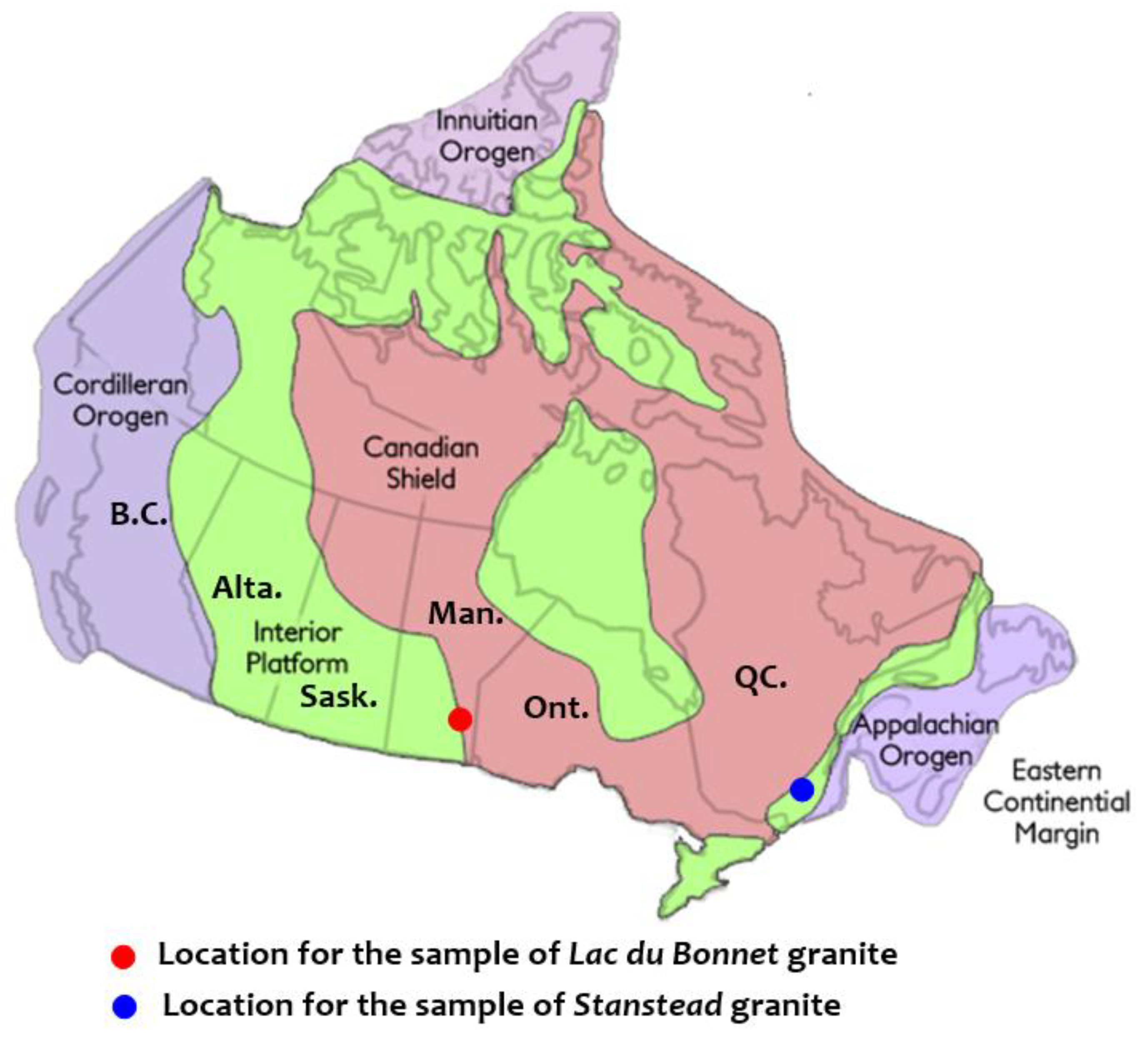
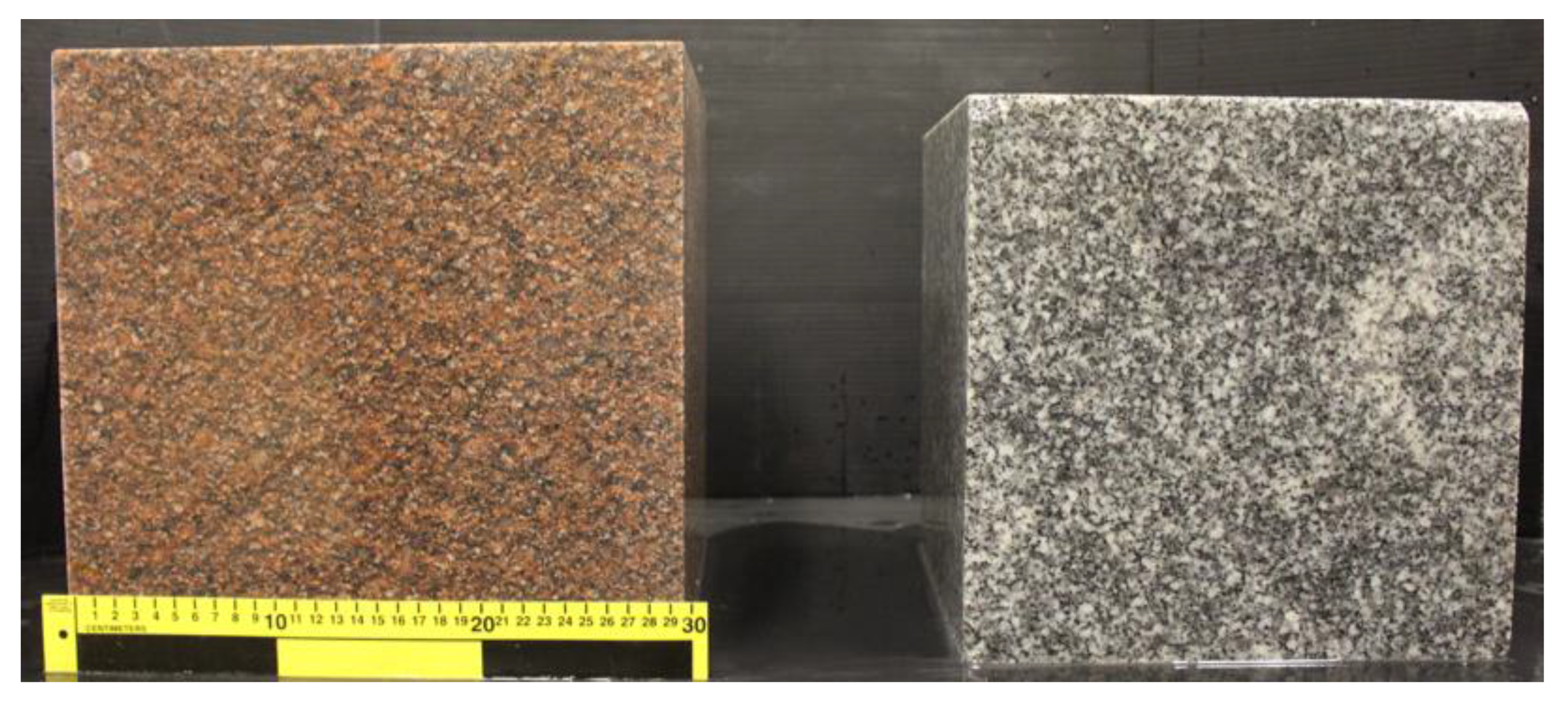
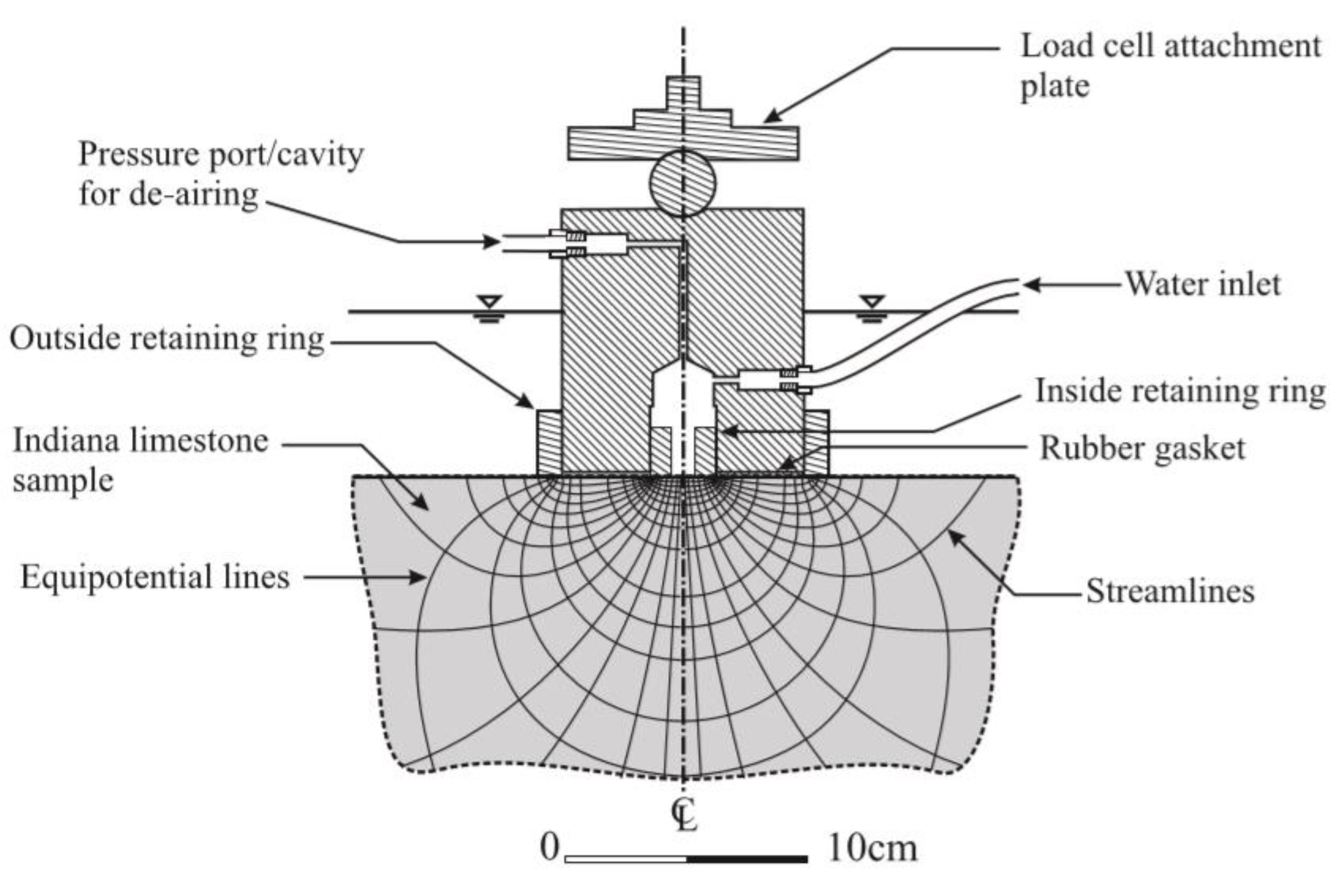
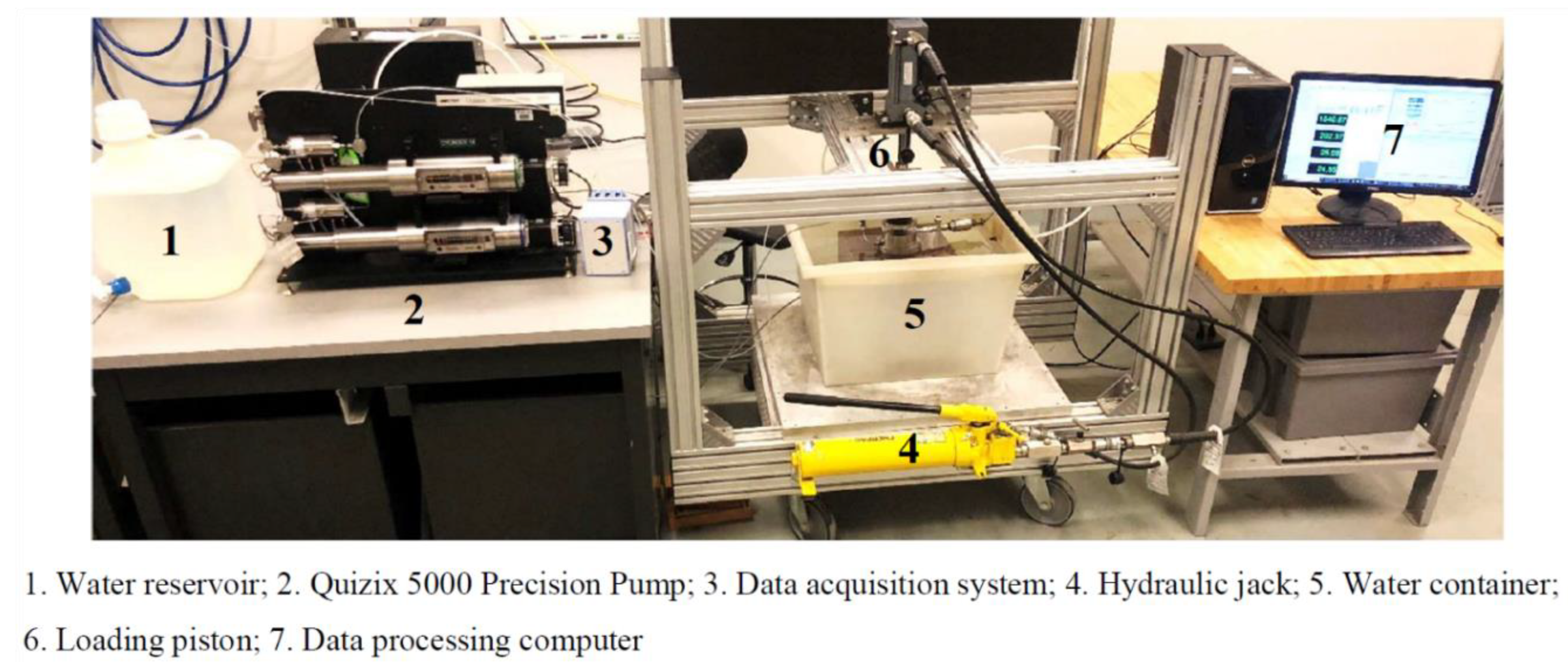
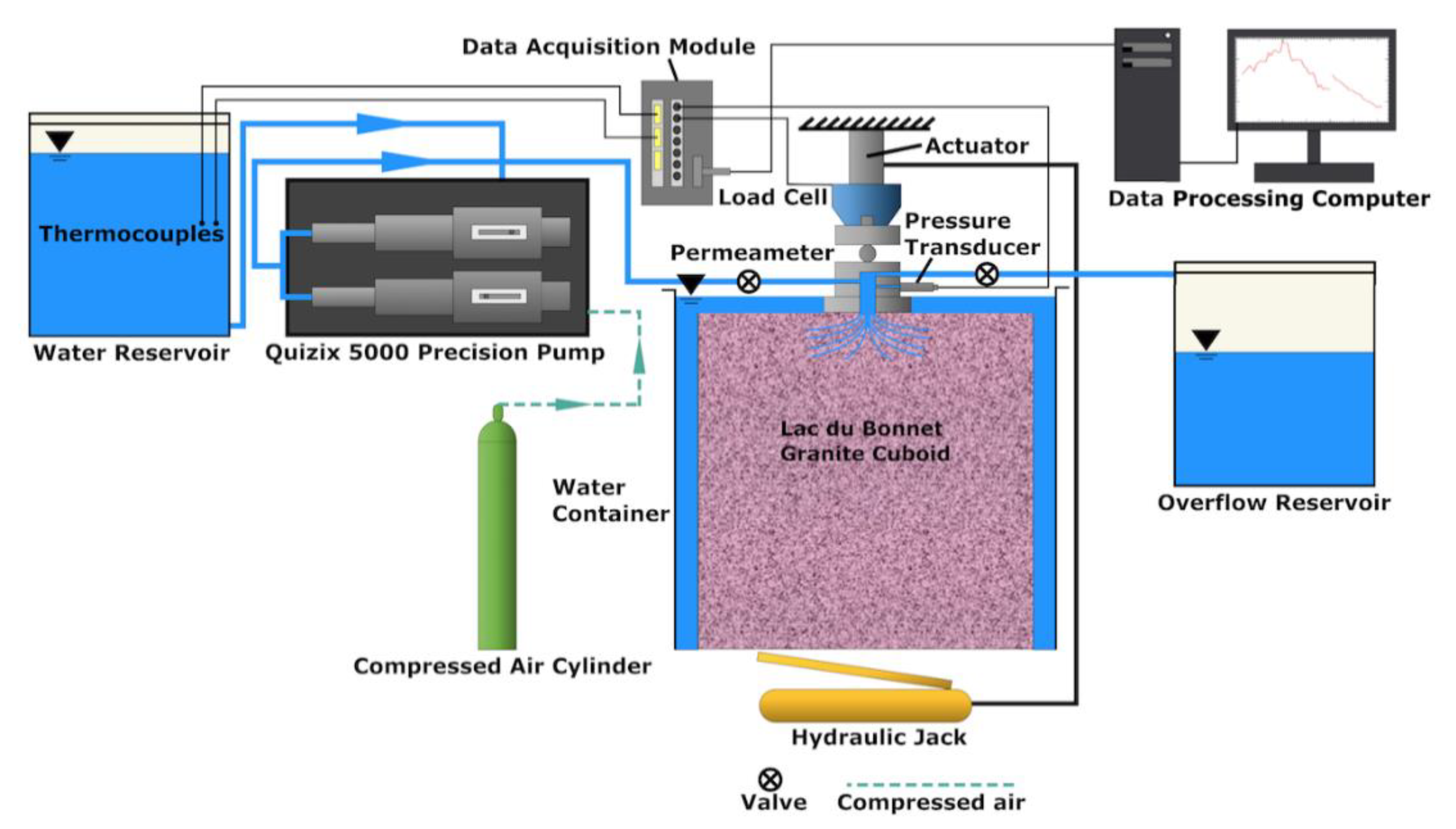
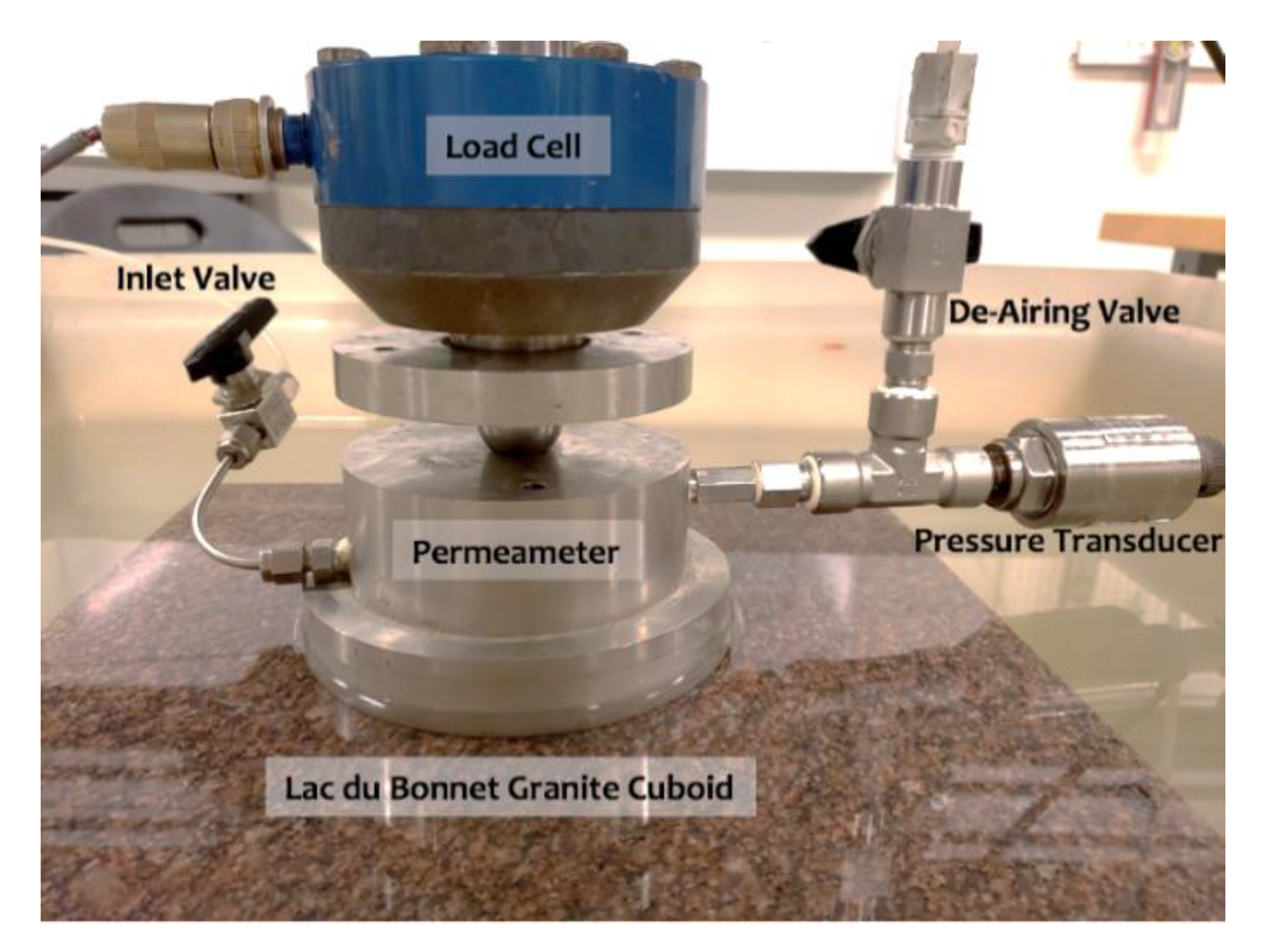
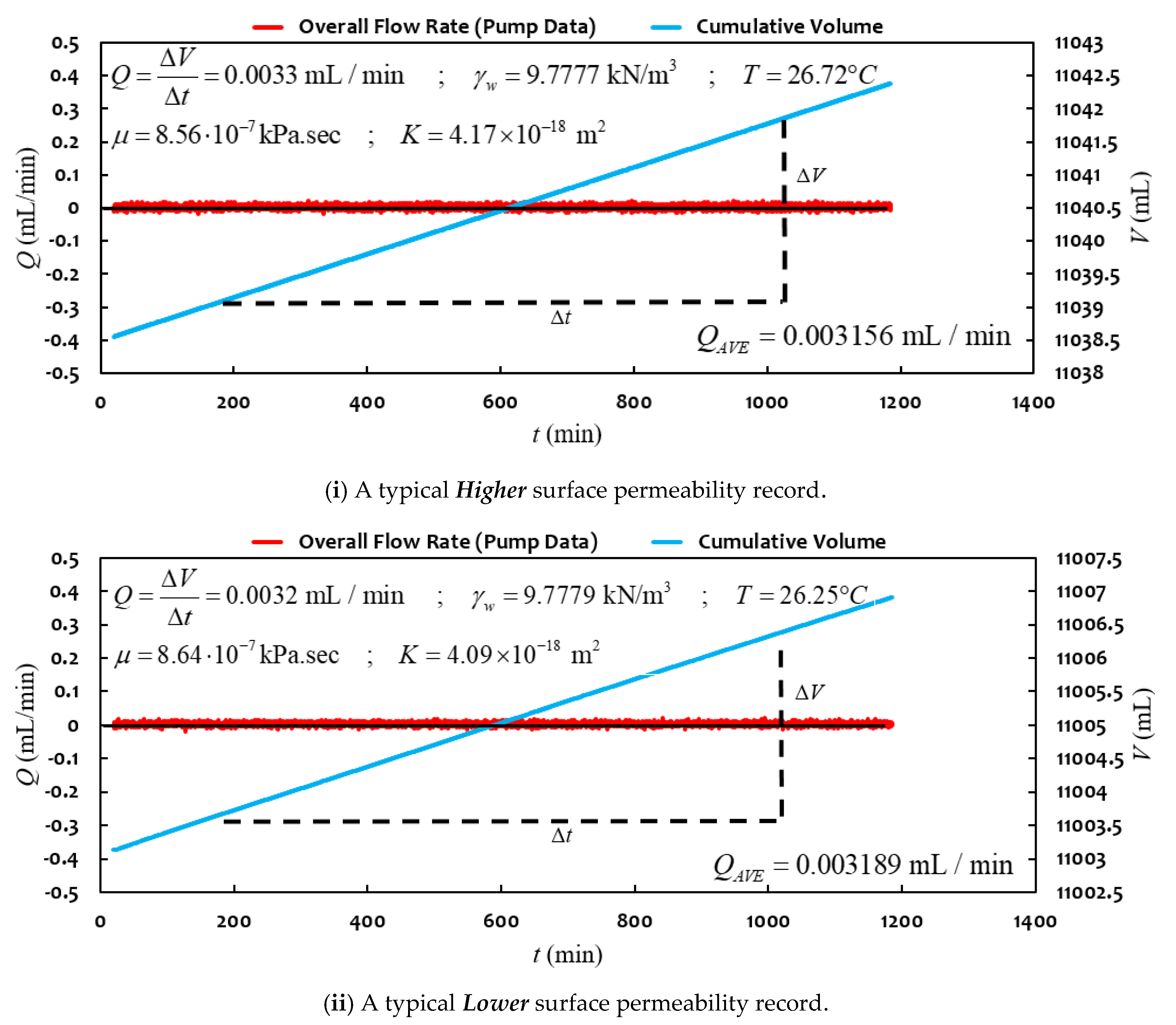
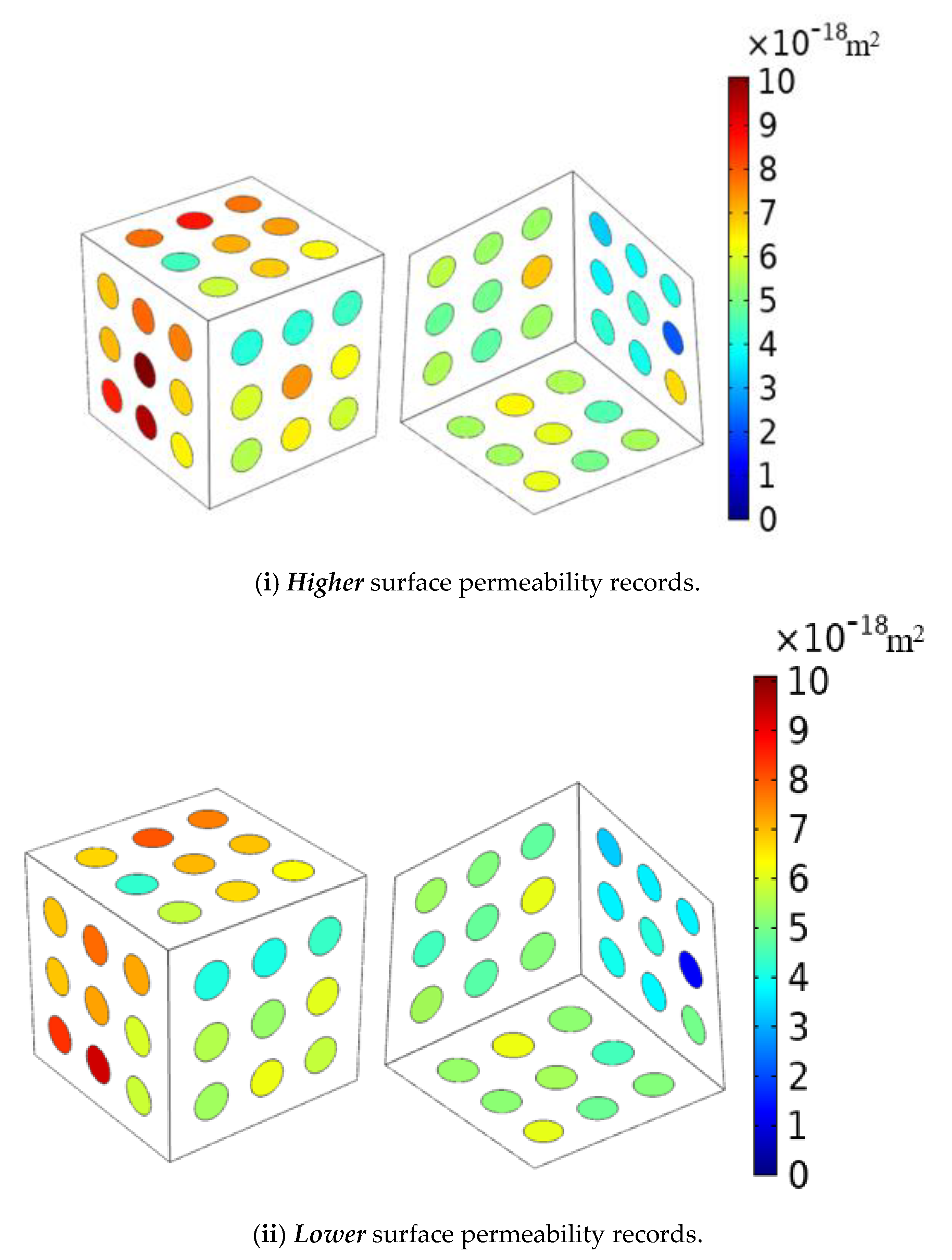
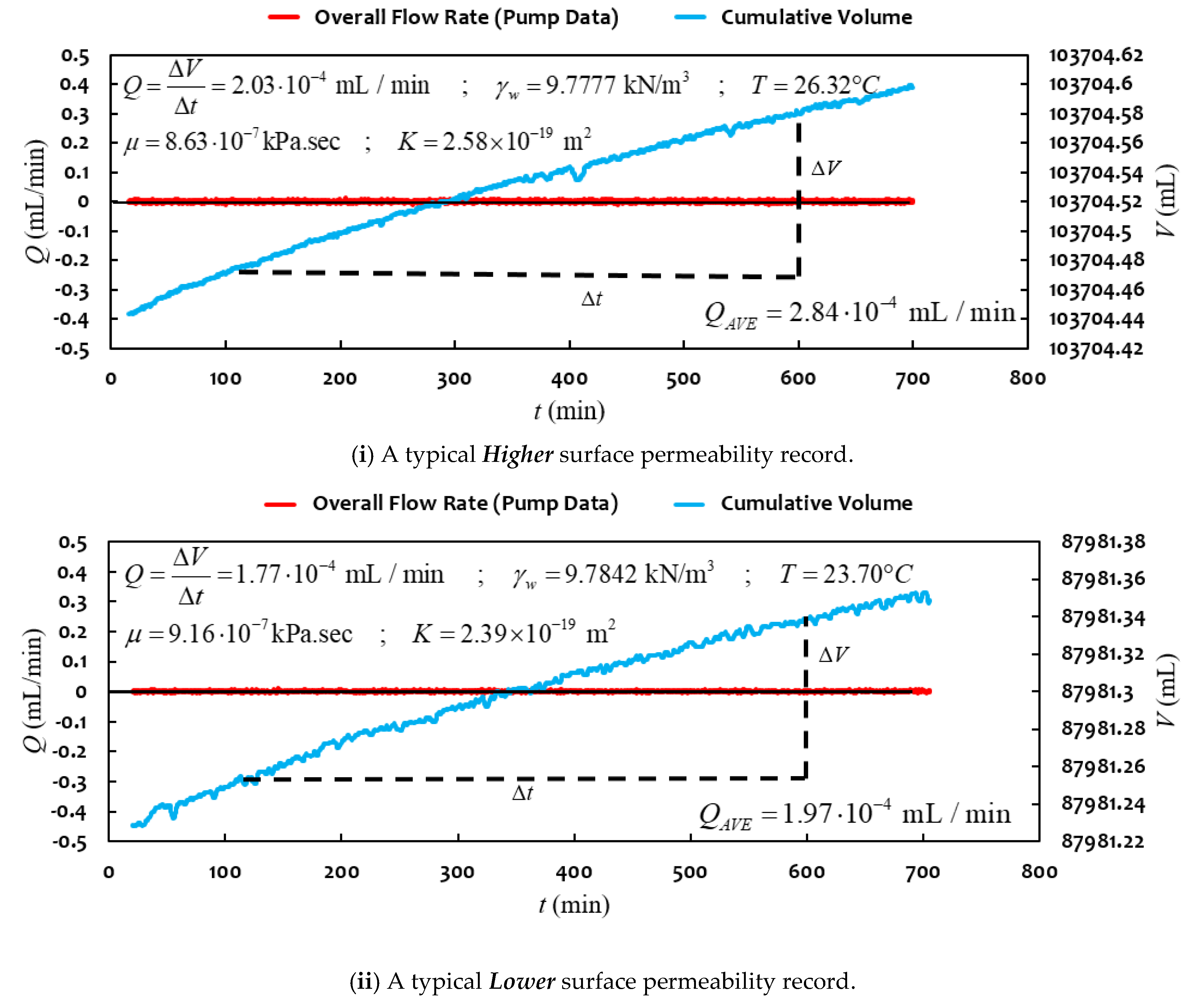
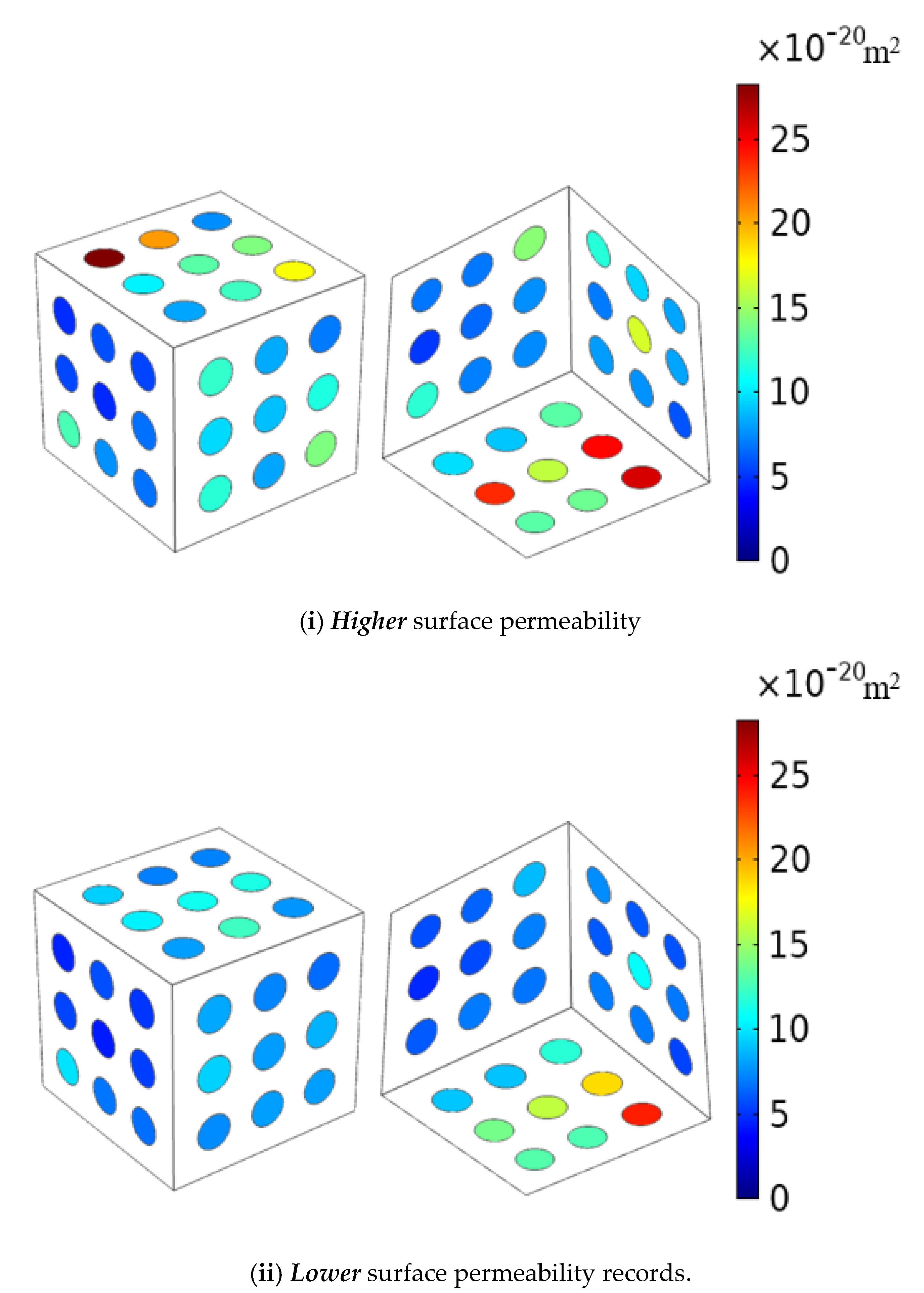
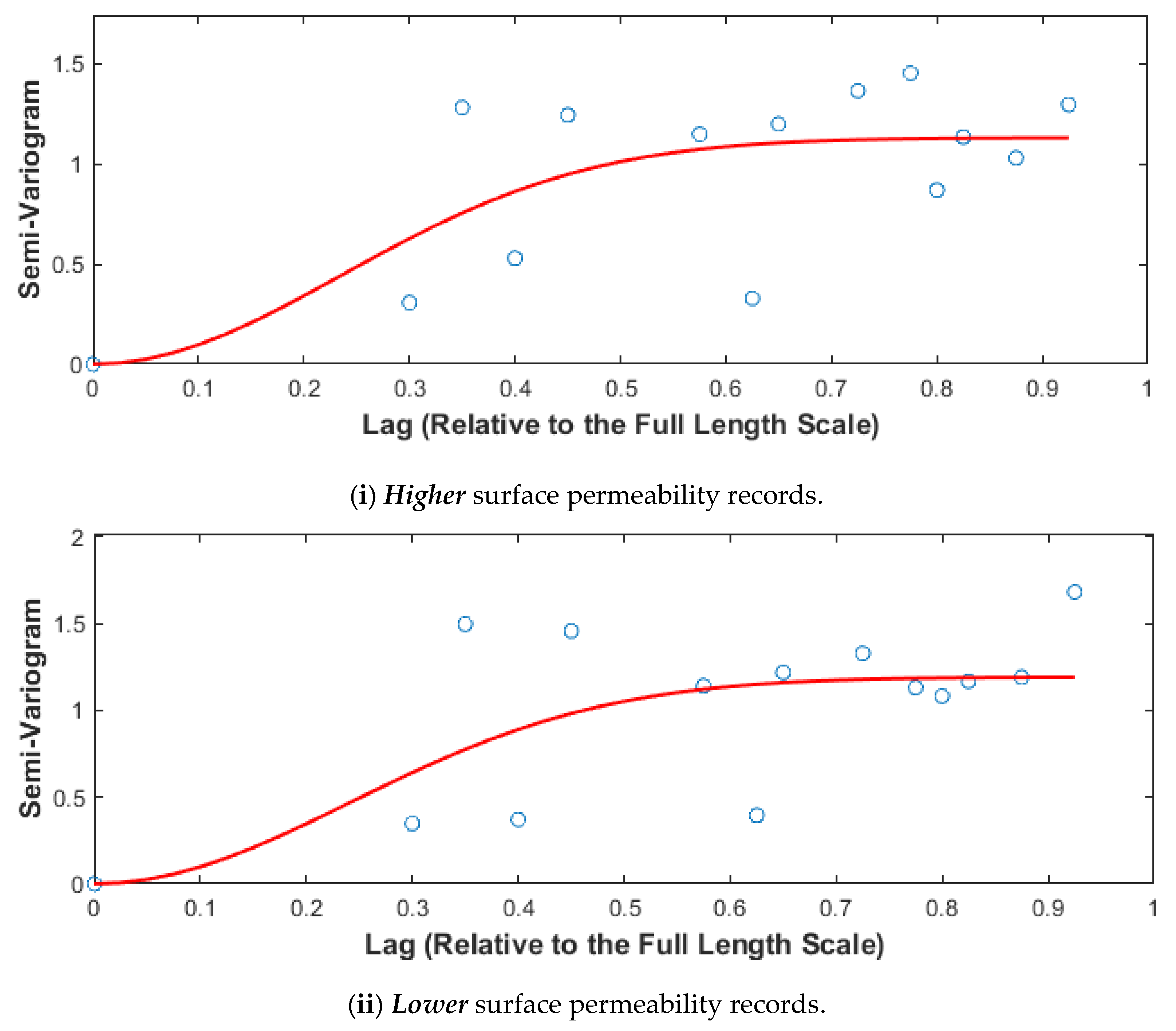
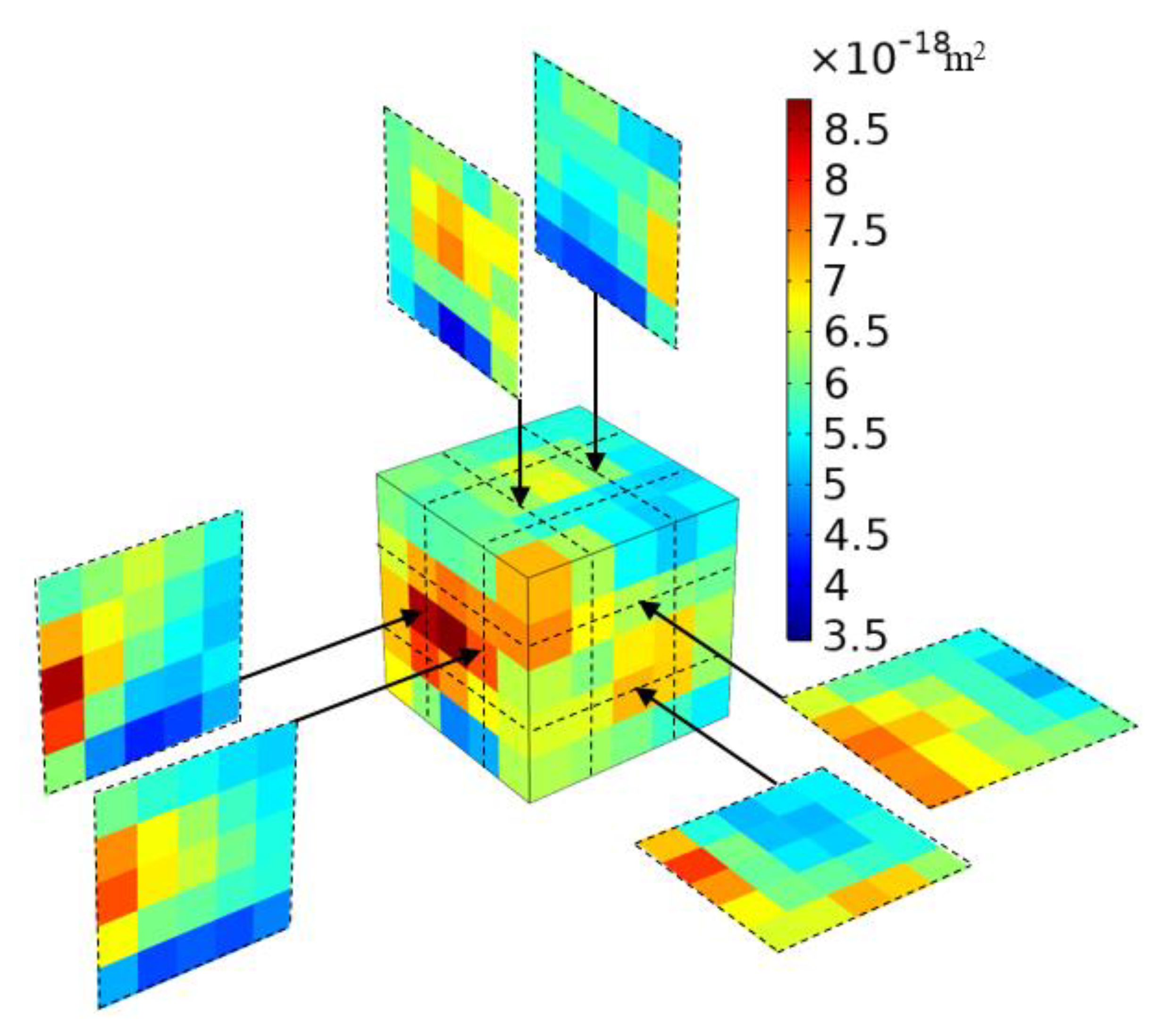
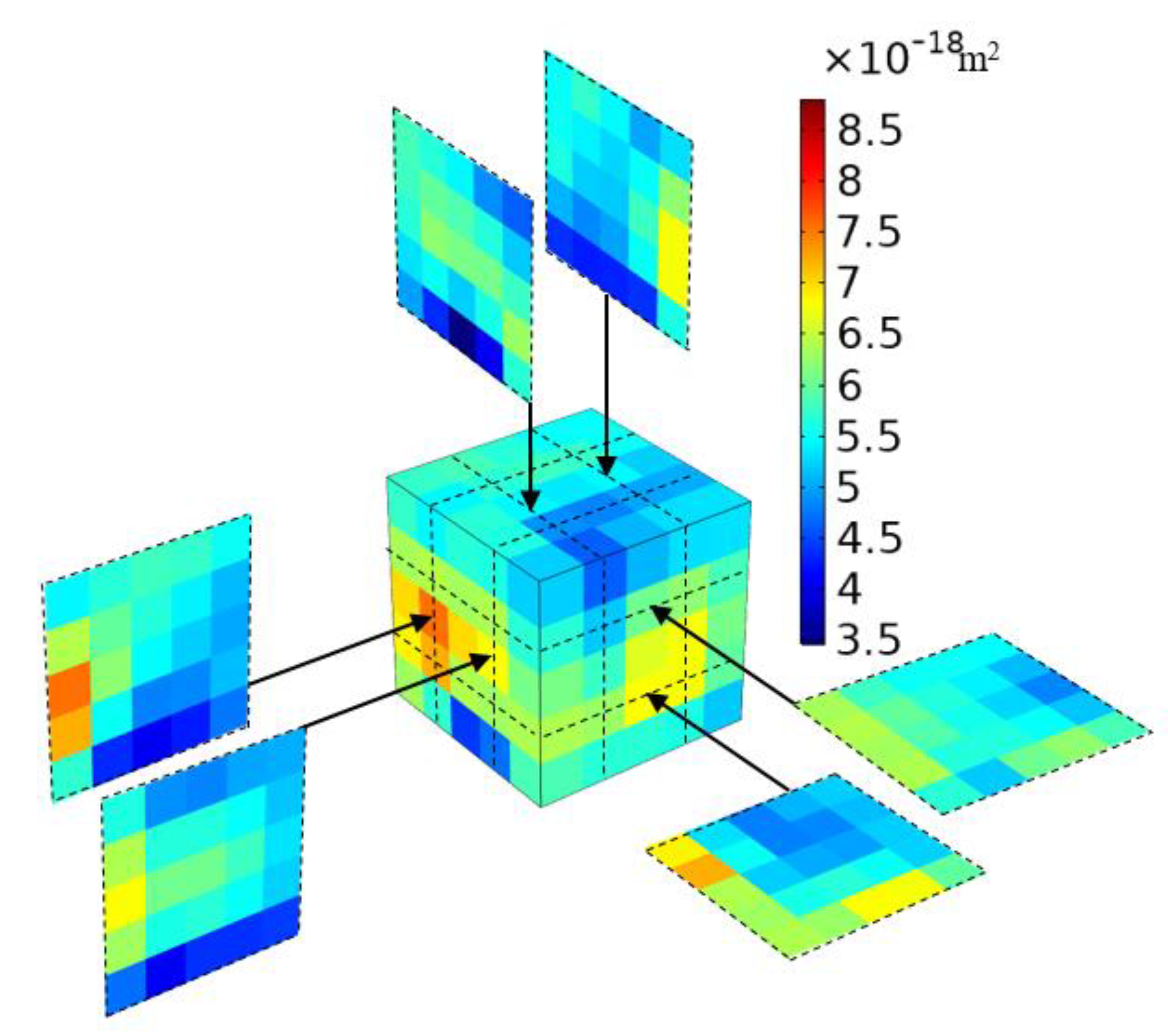
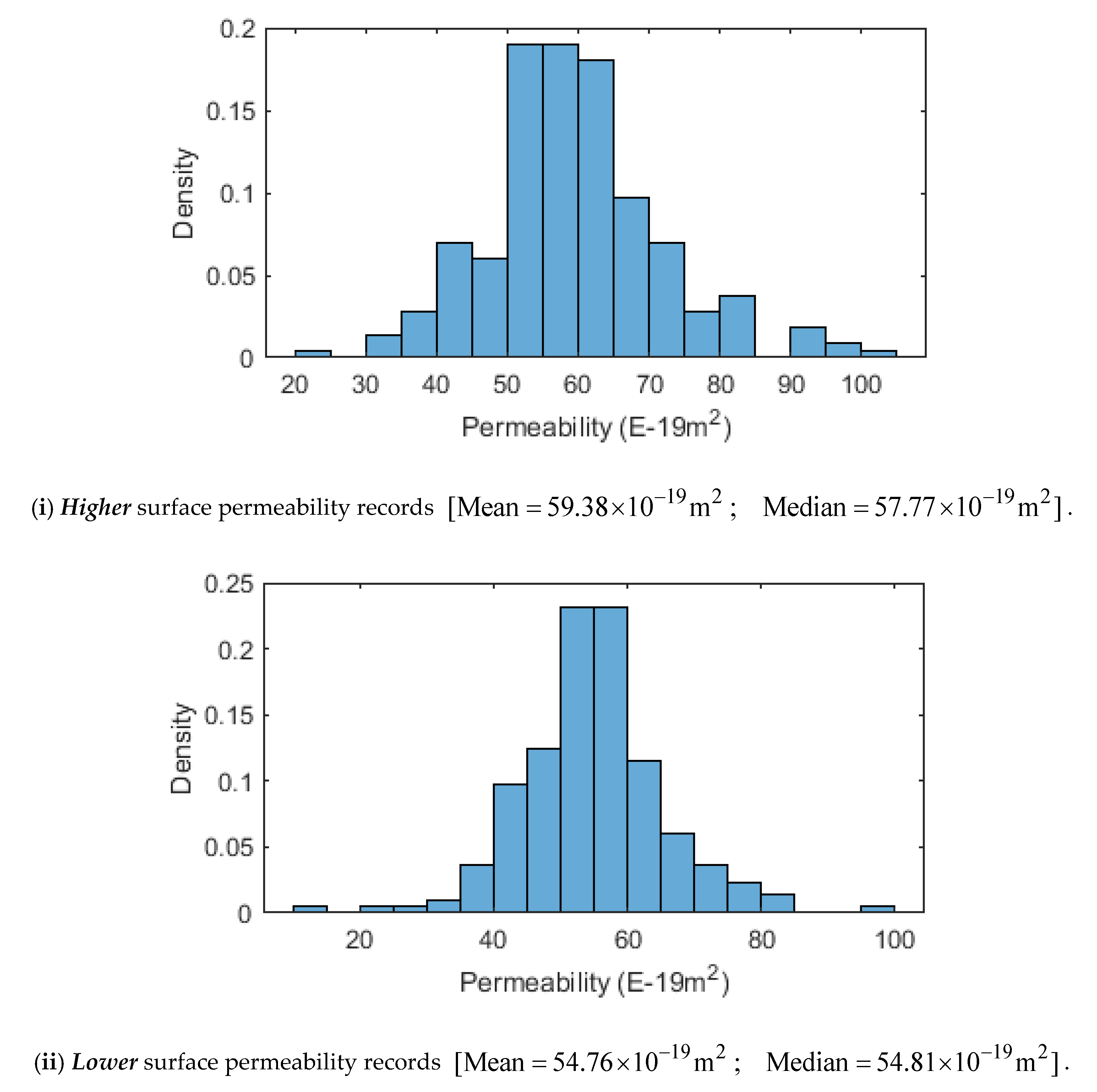
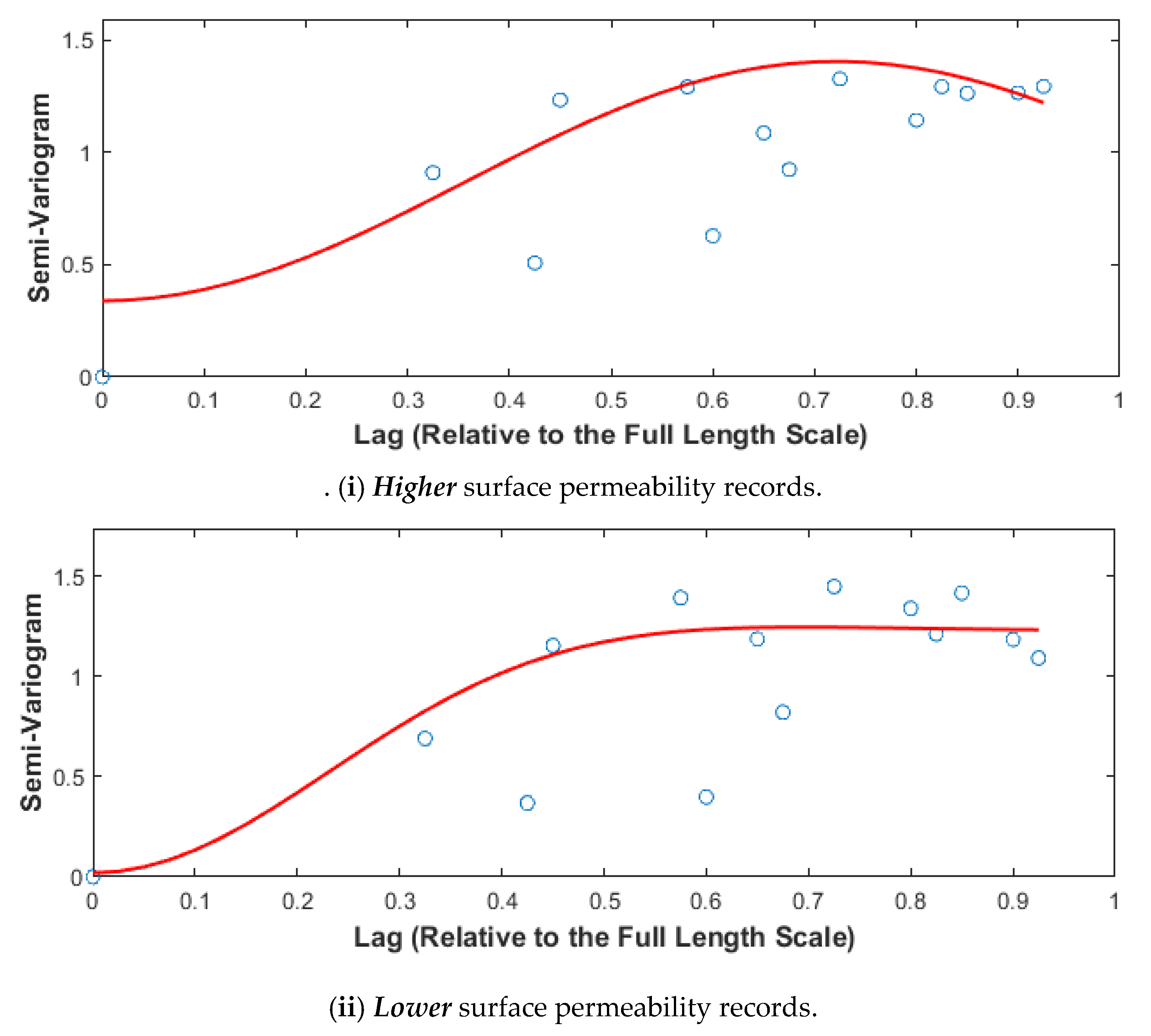
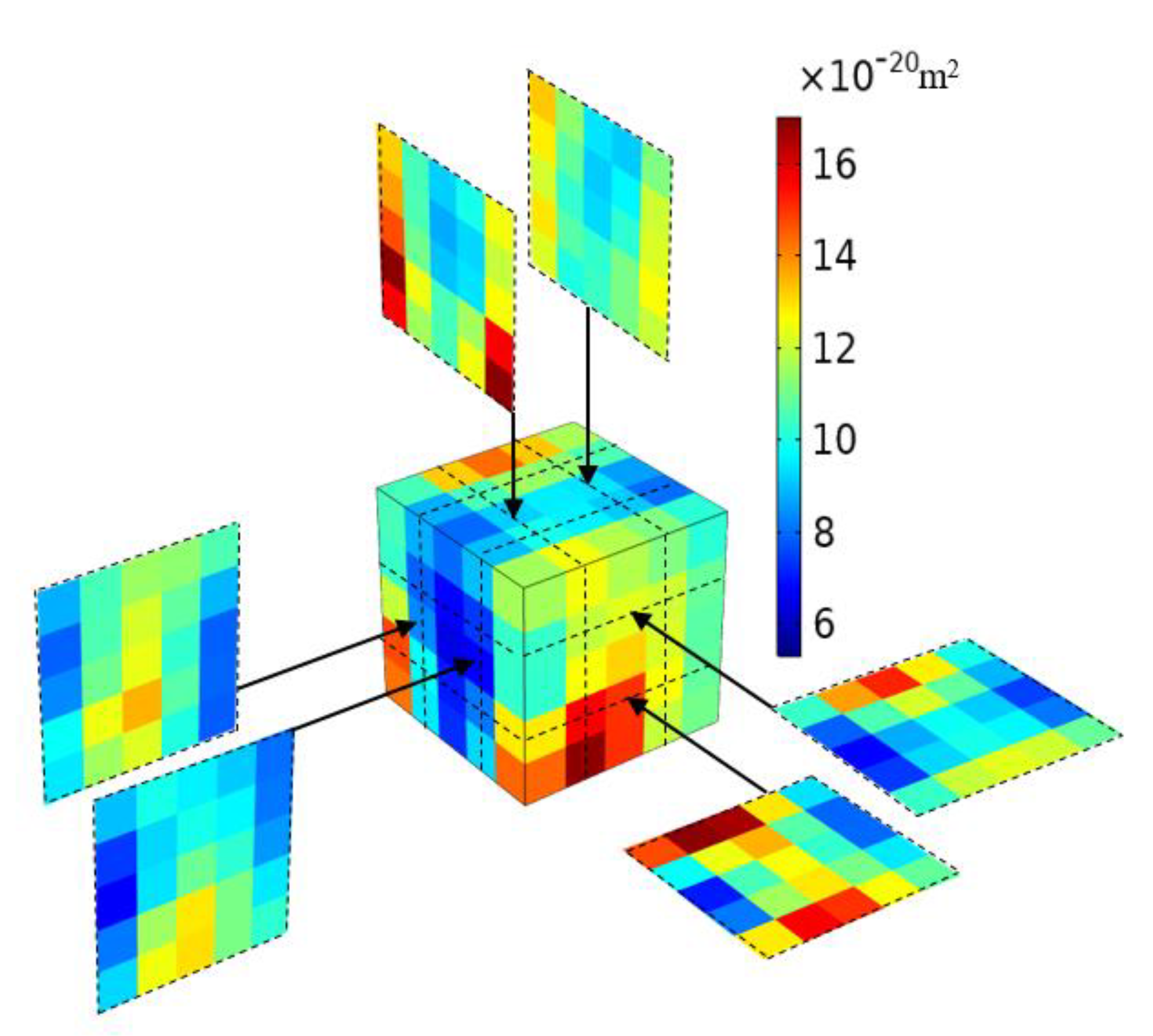
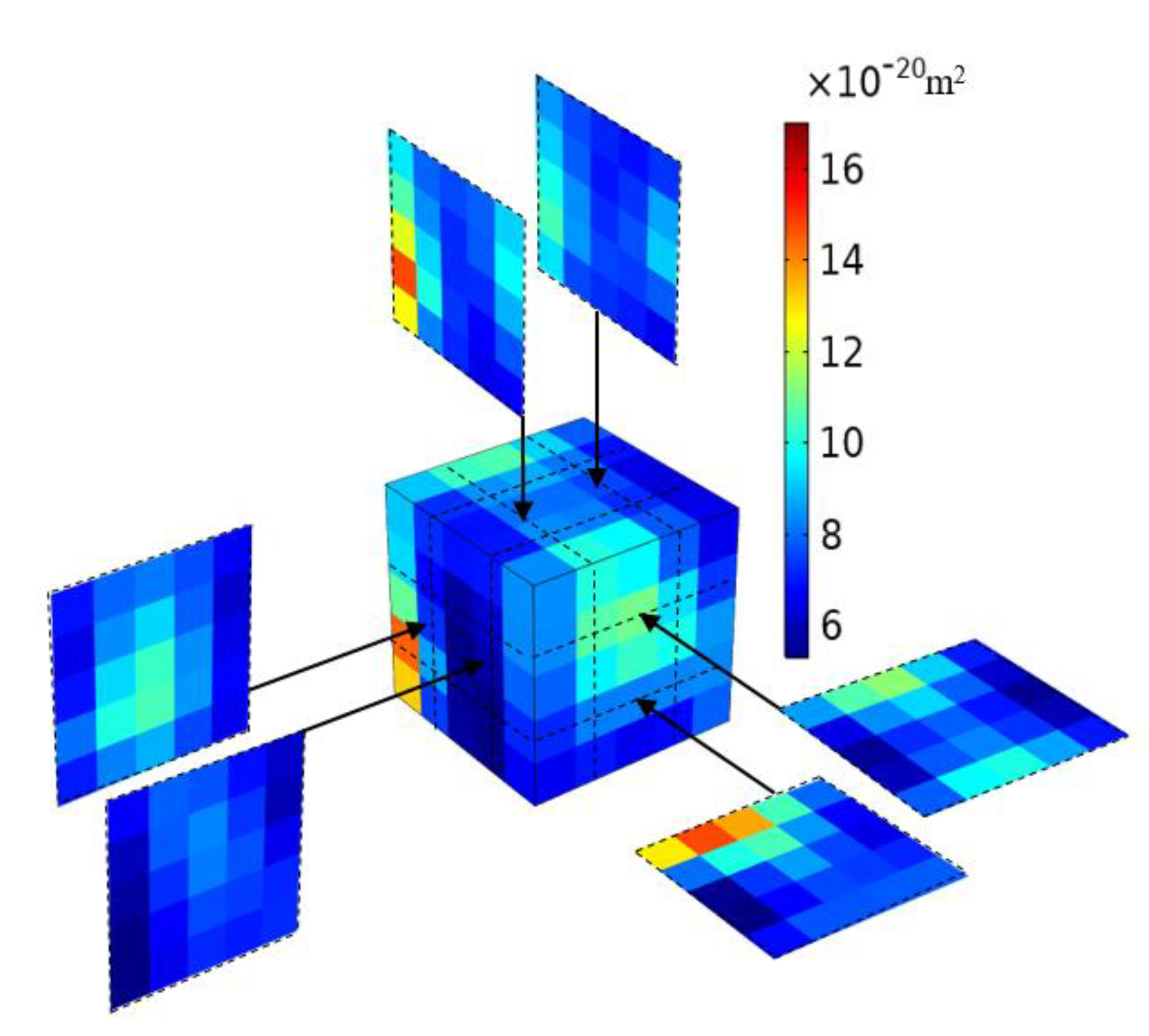
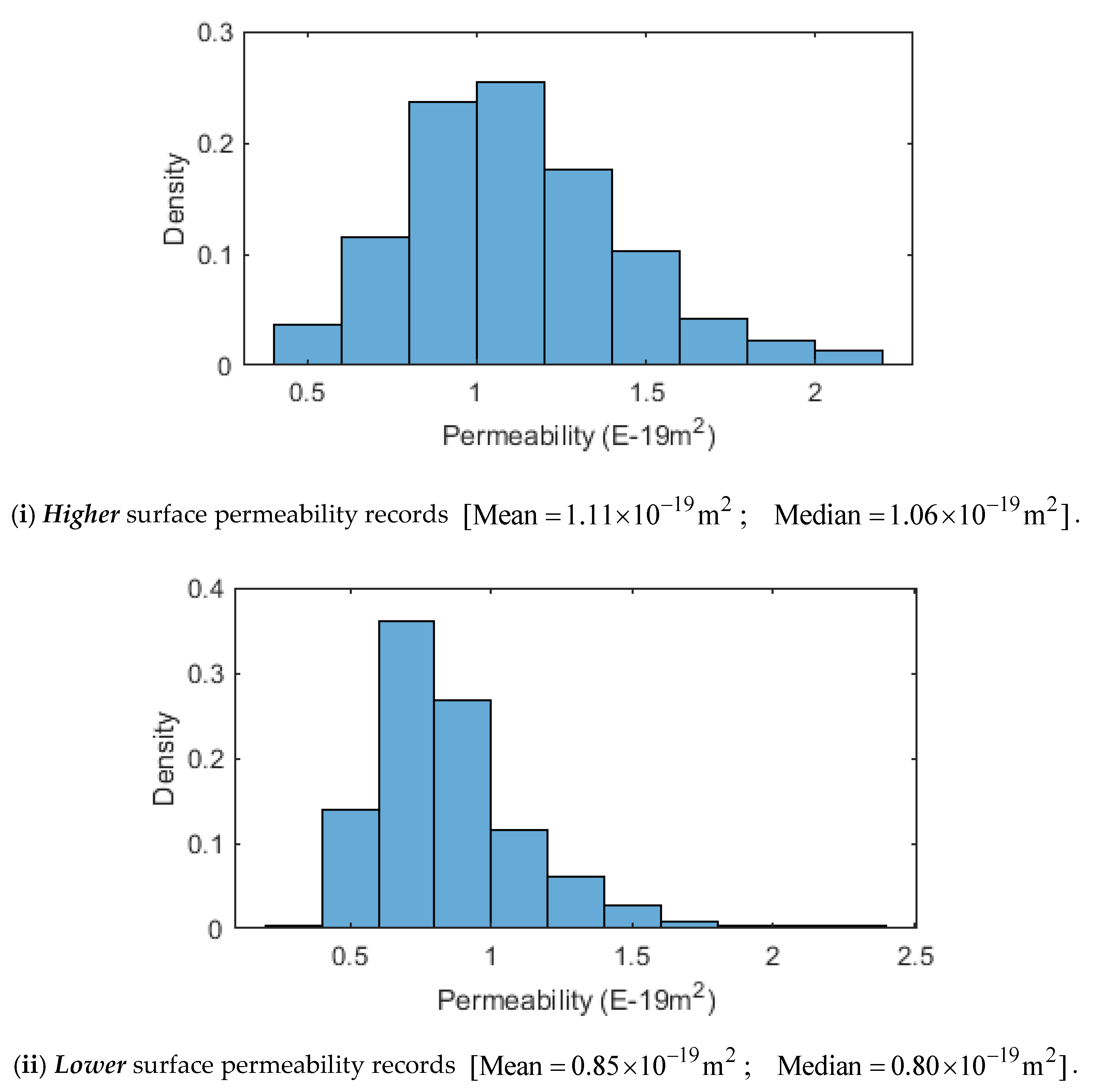
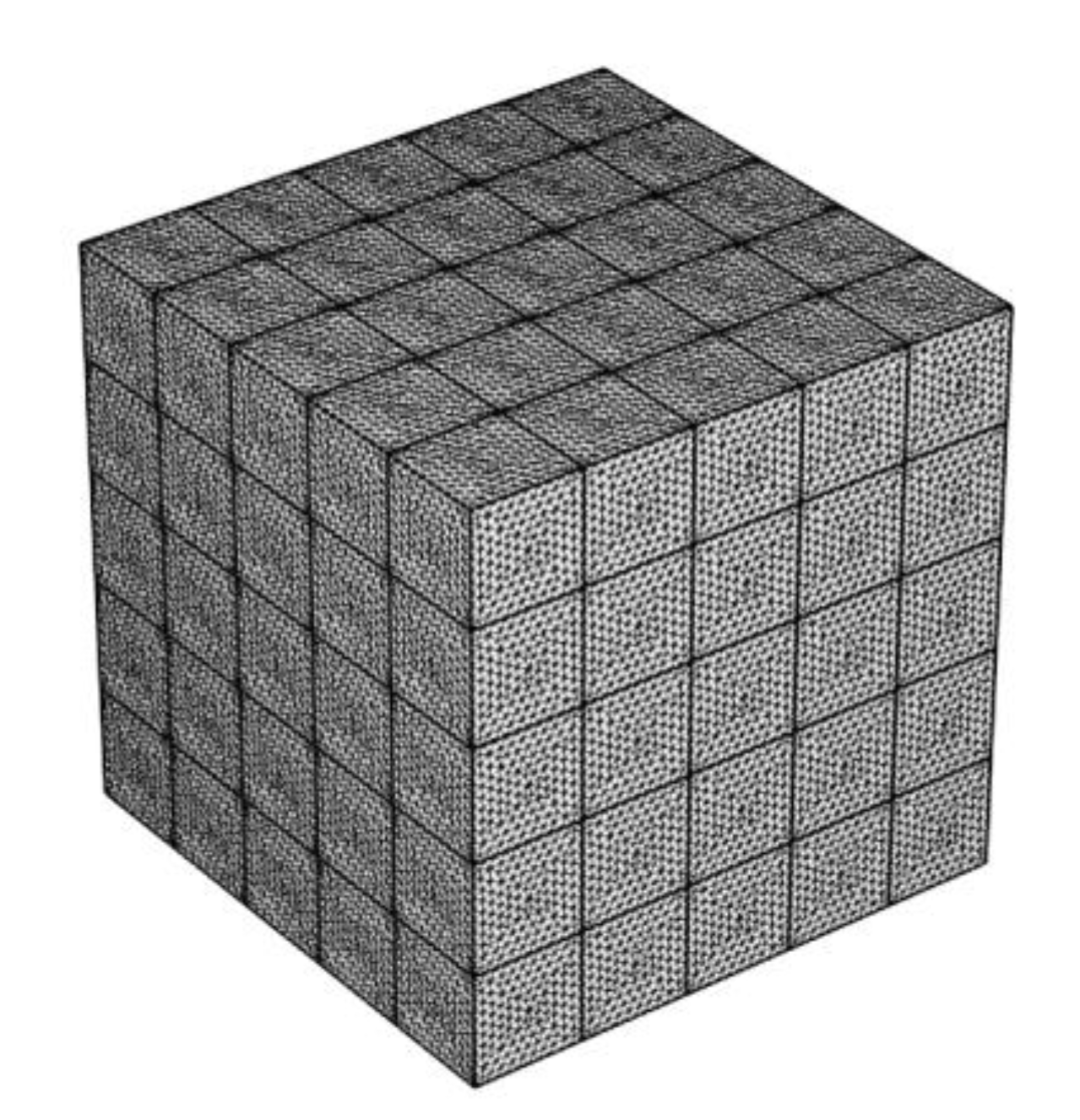
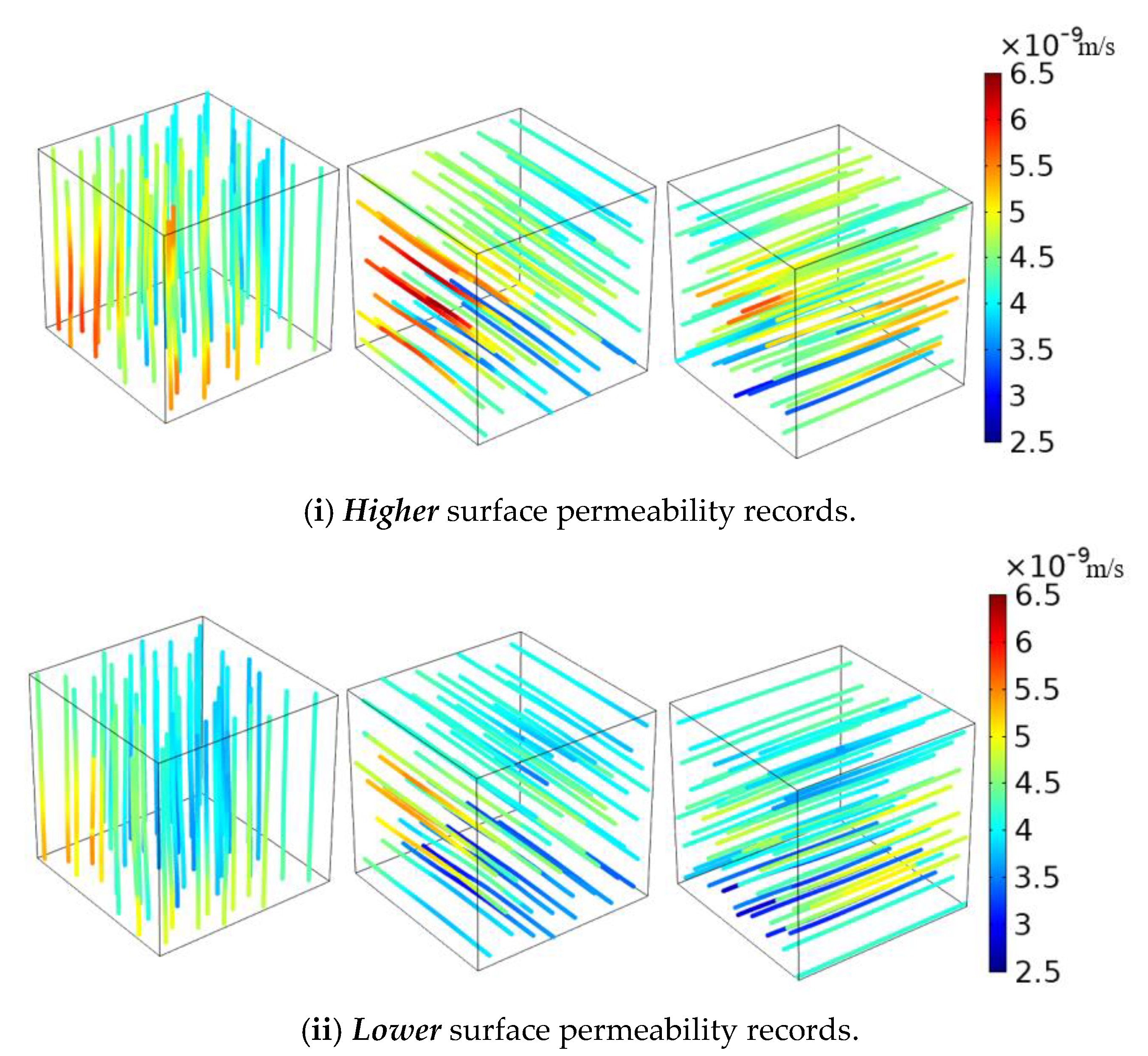
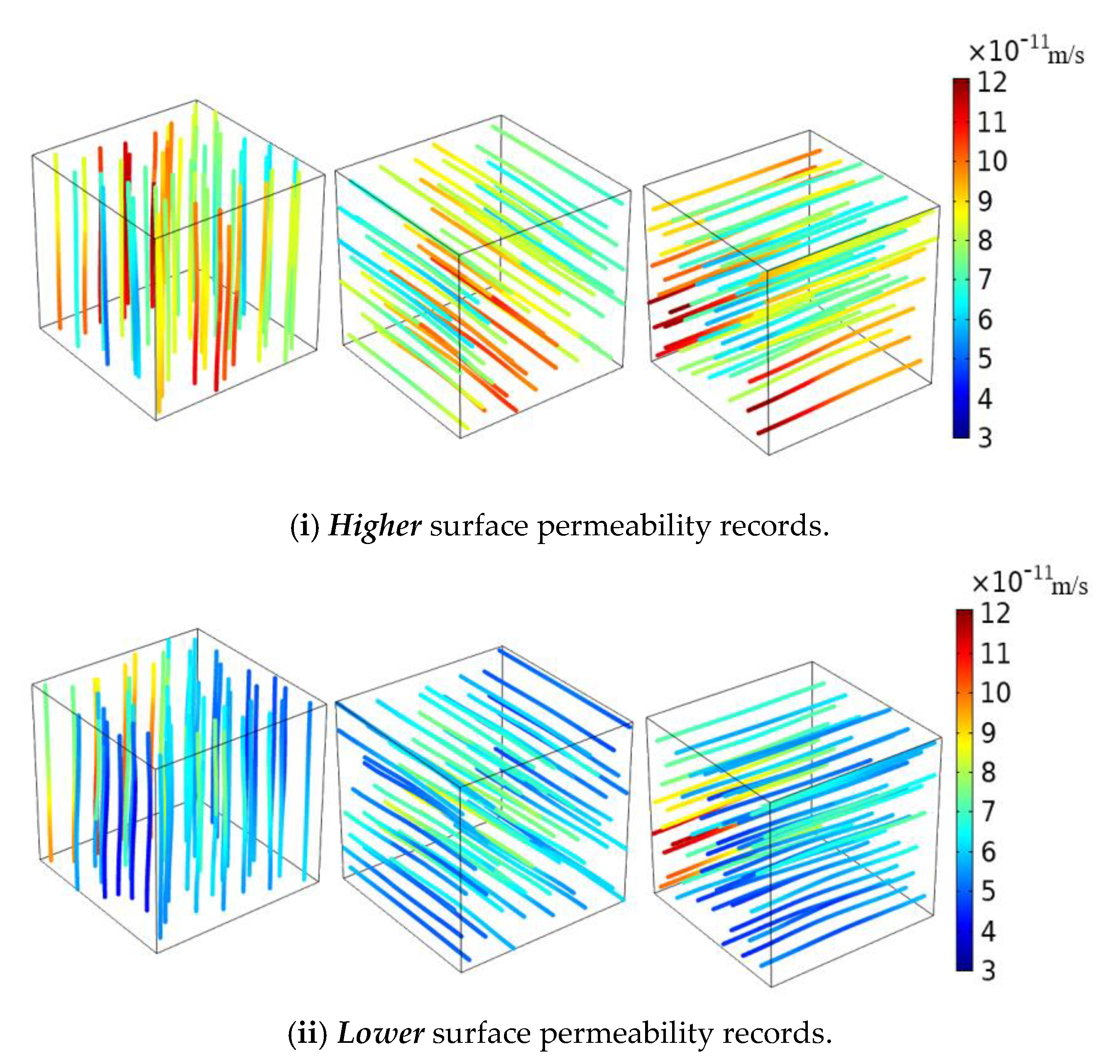
| Reference | Quartz (%) | Feldspar (%) | Mica (%) | Other (%) |
|---|---|---|---|---|
| McGill MIAM XRD Data | 38.6 | 58.9 | 2.5 | N/A |
| [103] | 24.7 | 66.7 | 0.6 | 8 |
| [104] | 20 | 72 | 8 | <1 |
| [105] | 43 | 50 | 5 | 2 |
| Reference | Quartz (%) | K-Feldspar (%) | Mica (%) | Other (%) |
|---|---|---|---|---|
| McGill MIAM XRD Data | 38.4 | 60.2 | 1.4 | - |
| [59] | 30 | 60 | <10 | - |
| [56] | 26.45 | 64.8 | 4.55 | 3.74 |
| [50] | 30 | 65 | 5 | - |
| [63] | 30 | 40 | 20 | 10 |
| Location | (i): The Higher K Value (ii): The Lower K Value | Surface 1 1019 m2) (Time in Mins) | Surface 2 1019 m2) (Time in Mins) | Surface 3 1019 m2) (Time in Mins) | Surface 4 1019 m2) (Time in Mins) | Surface 5 1019 m2) (Time in Mins) | Surface 6 1019 m2) (Time in Mins) |
|---|---|---|---|---|---|---|---|
| A | (i) | 60.7 (1315) | 73.9 (1215) | 49.2 (1040) | 71.2 (545) | 101.0 (2750) | 42.2 (2810) |
| (ii) | 54.4 (1275) | 53.0 (260) | 47.9 (1185) | 70.3 (955) | 72.3 (2700) | 41.2 (155) | |
| B | (i) | 54.1 (1330) | 42.0 (280) | 47.0 (265) | 68.3 (975) | 70.1 (395) | 39.8 (3255) |
| (ii) | 51.8 (1210) | 40.5 (1225) | 46.5 (1565) | 66.7 (1325) | 68.9 (1330) | 37.3 (4125) | |
| C | (i) | 45.8 (785) | 64.4 (145) | 53.4 (1580) | 86.6 (1105) | 67.3 (395) | 38.4 (1450) |
| (ii) | 44.6 (335) | 61.4 (880) | 50.8 (1525) | 80.1 (190) | 59.4 (1375) | 36.5 (4310) | |
| D | (i) | 55.1 (485) | 55.9 (185) | 56.5 (1145) | 77.3 (1060) | 76.0 (1035) | 33.1 (571) |
| (ii) | 52.0 (1110) | 53.9 (1365) | 53.7 (905) | 76.0 (1530) | 71.9 (2815) | 32.9 (1140) | |
| E | (i) | 63.8 (1570) | 59.1 (1495) | 48.1 (155) | 72.9 (4125) | 78.5 (370) | 37.1 (1045) |
| (ii) | 61.5 (1215) | 55.7 (1030) | 44.3 (1685) | 69.2 (1650) | 78.0 (1275) | 36.8 (469) | |
| F | (i) | 54.2 (1085) | 41.7 (1540) | 55.2 (1400) | 63.8 (1360) | 69.2 (170) | 42.3 (125) |
| (ii) | 52.9 (145) | 40.9 (1165) | 54.4 (2710) | 63.0 (1590) | 68.9 (885) | 39.6 (745) | |
| G | (i) | 61.4 (140) | 43.7 (325) | 53.4 (1255) | 88.5 (1220) | 85.6 (1025) | 56.7 (5823) |
| (ii) | 60.8 (1325) | 43.4 (1115) | 51.3 (315) | 42.7 (1205) | 83.7 (2960) | 49.4 (16590) | |
| H | (i) | 49.6 (295) | 62.8 (180) | 68.8 (5485) | 44.1 (240) | 96.4 (335) | 21.2 (1420) |
| (ii) | 48.5 (4010) | 60.4 (1365) | 60.9 (700) | 42.7 (475) | 93.2 (2660) | 11.9 (1380) | |
| I | (i) | 54.4 (175) | 58.1 (1070) | 53.3 (1180) | 77.8 (7285) | 64.3 (235) | 40.3 (1251) |
| (ii) | 51.0 (11145) | 57.4 (1160) | 47.4 (1095) | 67.2 (1185) | 58.0 (820) | 36.8 (1480) |
| Location | (i): The Higher K Value (ii): The Lower K Value | Surface 1 1019 m2) (Time in Mins) | Surface 2 1019 m2) (Time in Mins) | Surface 3 1019 m2) (Time in Mins) | Surface 4 1019 m2) (Time in Mins) | Surface 5 1019 m2) (Time in Mins) | Surface 6 1019 m2) (Time in Mins) |
|---|---|---|---|---|---|---|---|
| A | (i) | 1.59 (1085) | 0.883 (1320) | 0.639 (980) | 1.3 (2900) | 0.463 (2060) | 1.65 (900) |
| (ii) | 1.56 (1330) | 0.785 (1540) | 0.555 (2940) | 1.1 (660) | 0.426 (1195) | 1.07 (1460) | |
| B | (i) | 2.36 (1000) | 0.827 (1050) | 0.709 (1215) | 1.23 (5660) | 0.55 (1470) | 0.761 (1220) |
| (ii) | 1.38 (1955) | 0.722 (1230) | 0.689 (1425) | 1.23 (660) | 0.542 (1620) | 0.693 (4050) | |
| C | (i) | 2.46 (480) | 0.811 (1665) | 0.682 (1410) | 2.04 (535) | 0.662 (1675) | 0.944 (1110) |
| (ii) | 1.86 (400) | 0.791 (1400) | 0.625 (1065) | 0.709 (1395) | 0.526 (5215) | 0.592 (940) | |
| D | (i) | 1.3 (335) | 1.17 (1520) | 0.675 (1985) | 0.747 (1460) | 0.542 (1350) | 1.16 (1250) |
| (ii) | 1.17 (1395) | 0.739 (1170) | 0.562 (895) | 0.716 (1085) | 0.498 (1550) | 0.746 (4375) | |
| E | (i) | 0.903 (4130) | 0.956 (850) | 0.506 (1540) | 1.41 (605) | 0.572 (2820) | 0.693 (1575) |
| (ii) | 0.895 (685) | 0.935 (970) | 0.462 (1335) | 1.13 (1460) | 0.569 (1190) | 0.597 (1030) | |
| F | (i) | 0.97 (1640) | 1.2 (860) | 1.18 (1275) | 1.75 (785) | 0.475 (1050) | 0.789 (1540) |
| (ii) | 0.901 (1645) | 0.819 (675) | 0.601 (3195) | 0.768 (1670) | 0.446 (920) | 0.698 (1345) | |
| G | (i) | 1.3 (675) | 0.69 (1000) | 0.738 (1575) | 1.88 (1040) | 1.26 (870) | 0.583 (1475) |
| (ii) | 1.29 (3470) | 0.648 (1425) | 0.674 (1510) | 1.2 (1045) | 0.983 (930) | 0.539 (675) | |
| H | (i) | 1.36 (1130) | 1.14 (1140) | 0.751 (1240) | 1.03 (1225) | 0.756 (2485) | 0.811 (825) |
| (ii) | 1.27 (1075) | 0.847 (3300) | 0.706 (1255) | 1.02 (1300) | 0.679 (1710) | 0.684 (615) | |
| I | (i) | 2.58 (955) | 1.41 (1065) | 1.44 (1215) | 2.82 (375) | 0.667 (1380) | 1.24 (830) |
| (ii) | 2.39 (675) | 0.795 (1185) | 0.875 (1375) | 0.929 (1285) | 0.657 (1140) | 0.579 (1360) |
| Reference | Sample Dimensions | Porosity | Permeability |
|---|---|---|---|
| [82] | 100 mm long and 49 mm diameter sample with a 7 mm diameter cavity | 0.005~0.016 | |
| [84] | 305 mm long and 150 mm diameter sample with a 25 mm diameter and 150 mm long cavity | 0.006 | |
| [122] | 50 mm diameter and 25 mm in length | 0.002 | |
| EGL (McGill) | Cuboidal samples measuring 100 mm | 0.0077 | N/A |
© 2020 by the authors. Licensee MDPI, Basel, Switzerland. This article is an open access article distributed under the terms and conditions of the Creative Commons Attribution (CC BY) license (http://creativecommons.org/licenses/by/4.0/).
Share and Cite
Selvadurai, A.P.S.; Blain-Coallier, A.; Selvadurai, P.A. Estimates for the Effective Permeability of Intact Granite Obtained from the Eastern and Western Flanks of the Canadian Shield. Minerals 2020, 10, 667. https://doi.org/10.3390/min10080667
Selvadurai APS, Blain-Coallier A, Selvadurai PA. Estimates for the Effective Permeability of Intact Granite Obtained from the Eastern and Western Flanks of the Canadian Shield. Minerals. 2020; 10(8):667. https://doi.org/10.3390/min10080667
Chicago/Turabian StyleSelvadurai, A. P. S., A. Blain-Coallier, and P. A. Selvadurai. 2020. "Estimates for the Effective Permeability of Intact Granite Obtained from the Eastern and Western Flanks of the Canadian Shield" Minerals 10, no. 8: 667. https://doi.org/10.3390/min10080667
APA StyleSelvadurai, A. P. S., Blain-Coallier, A., & Selvadurai, P. A. (2020). Estimates for the Effective Permeability of Intact Granite Obtained from the Eastern and Western Flanks of the Canadian Shield. Minerals, 10(8), 667. https://doi.org/10.3390/min10080667






